








By Reine Juvierre S. Alberto @reine_alberto
THE national government’s outstanding debt climbed to P15.483 trillion as of end-June 2024, according to the Bureau of the Treasury (BTr).
Data from the Treasury showed the state’s debt increased by 9.4 percent to P15.483 trillion in June 2024 from the P14.147-trillion debt recorded in the same month a year ago. Compared to the end-May 2024 level at P15.347 trillion, the oustanding debt recorded a flat growth by 0.9 percent or P135.90 billion. This is due to the net issuance of both domestic and external debt and the effect of peso depreciation, which was partially offset by the impact of thirdcurrency depreciation on the valuation of corresponding debt denominated in those currencies, the Treasury explained. The bulk of the government’s outstanding debt is domestic debt at 68.29 percent. The remaining is external or foreign debt at 31.71 percent of the overall debt. Broken down, domestic debt jumped by 9 percent, or P870.29 billion, to P10.573 trillion in June 2024 from P9.702 trillion in the same month in 2023. Domestic debt also increased by 1.2 percent, or P130.28 billion, from the P10.442 trillion recorded in end-May 2024. The increase in domestic debt was primarily driven by the P129.89-billion net issuance of government securities and the P0.39-billion effect of
depreciation on foreign-currencydenominated domestic debt, according to the Treasury.
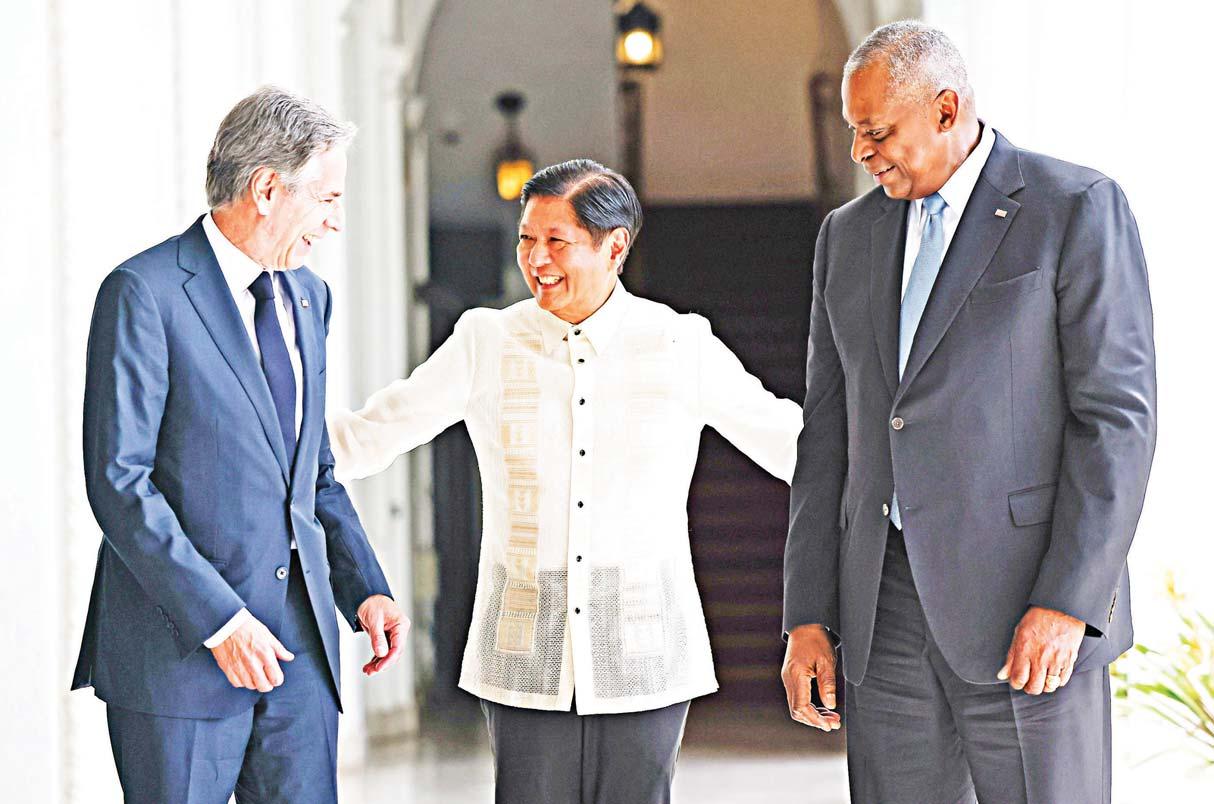
EBy Ada Pelonia @adapelonia
GGS and vegetables will become more expensive following the agricultural damage brought by typhoon Carina and the southwest monsoon.
Agriculture Assistant Secretary and Spokesman Arnel De Mesa said it is possible to see a slight increase in egg prices since different stakeholders reported that some warehouses were affected by the typhoon.
“However, this would be a very slight increase because no layer farms have been
affected,” De Mesa told reporters in Filipino.
The price of small white eggs in Metro Manila markets reached as high as P8.50 per piece as of July 29, according to the latest price monitoring report of the DA. This was higher than the P7.50 per piece recorded on July 16.
“Vegetable prices may increase slightly because vegetable-producing areas were also affected, particularly for high-value commercial crops,” he added.
Carrot prices registered an increase to P150-P230 per kilo on July 29 from P100-P170 per
kilo on July 16. Scorpio cabbage prices jumped to as high as P100 per kilo yesterday from P90 per kilo two weeks ago.
The DA recently reported that damage sustained by the agriculture sector following heavy rainfall from typhoon Carina and the southwest monsoon has reached nearly P700 million.
The volume of production losses in Cordillera Administrative Region (CAR), Ilocos, Central Luzon, Calabarzon, Mimaropa, Bicol, Western and Eastern Visayas, Zamboanga


US announces ₧29.3-B military funding to PHL
By Malou Talosig-Bartolome
MERICA’S top diplomat and defense chief announced Tuesday that the US Congress will allot US$500 million (around P29.327 billion) for the Philippines to help fund its military modernization program as China’s aggression in the region “concerns” many US allies in the Indo-Pacific region.
US State Secretary Antony Blinken and Defense Secretary Lloyd Austin III announced this after their 2+2 Ministerial Meeting in Manila with their Philippine counterparts, Foreign Affairs Secretary Enrique Manalo and Defense Secretary Gilberto Teodoro Jr.
“Our relationship between the United States and the Philippines [is] the strongest [it has] ever been. Today’s talks built on that unprecedented momentum in a number of concrete ways...We are now allocating an additional
See “Funding,” A

THE agricultural damage caused by typhoon Carina and the southwest monsoon (habagat) has breached P1 billion, according to the Department of Agriculture (DA).
In its latest bulletin, the DA said the agricultural damage reached a total of P1.17 billion and affected 40,904 farmers and fisherfolk.
The volume of production losses in Cordillera Administrative Region (CAR), Ilocos, Cagayan Valley, Central Luzon, Calabarzon, Mimaropa, Bicol, Western and Eastern Visayas, Zamboanga Peninsula, Soccsksargen and Caraga regions was pegged at
US$500 million for Foreign Military Financing to the Philippines to boost security collaboration with our oldest treaty ally in this region,” Blinken said during press conference.
The US$500-million financing is part of the US$2-billion
18,086 metric tons (MT).
The report showed rice sustained the majority of the damage at 10,272 MT where most of the damage and losses were in newly planted, vegetative, and reproductive stages. Other agricultural commodities that suffered from the onslaught of typhoon Carina and the southwest monsoon were corn at 3,104 MT and high-value crops at 1,951 MT.
The report said the damage from high-value crops include upland and lowland vegetables, papaya, and banana. According to DA, the total
line item that the US Congress has allocated in a supplemental budget for Taiwan.
Sources said the US State and Defense departments have asked the US Congress to allocate a fourth of the FMF supplemental budget to the Philippines. “The US Congress has yet to approve this proposal, but both departments are confident it will be approved,” an official said.
area affected is 42,708 hectares (ha), with 31,491 hectares having chance for recovery.
The report said the production losses are equivalent to P660.60 million for rice, P65.40 million for rice, P79.35 million for high-value crops, P360.80 million for fisheries, P1.32 million for livestock, and P1.6 million for infrastructure, machinery, and equipment.
The DA said it would provide 72,174 bags of rice seeds, 39,546 bags of corn seeds, 59,600 pouches, and 1,966 kilograms of vegetable seeds.
The Bureau of Fisheries and Aquatic Resources (BFAR) will also
On top of this financial assistance is the US$128 million (P7.3 billon) that the US State Department has invested for the nine sites in the Philippines where US troops can access under the Enhanced Defense Cooperation Agreement (Edca).
Secretary Teodoro said the Philippines and US will identify the priority defense spending in the Security Assistance Sector
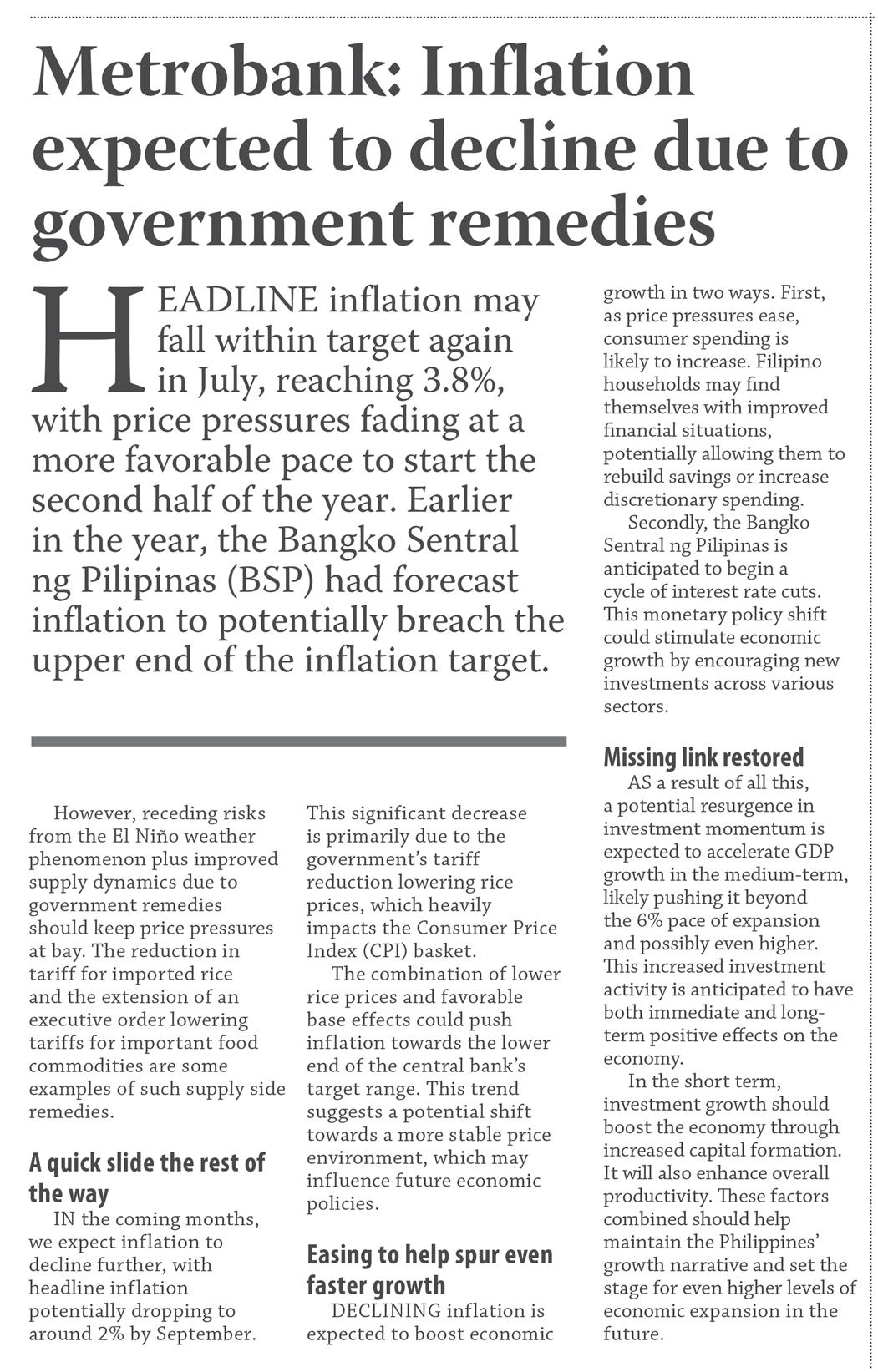
Year-to-date, domestic debt rose by 5.5 percent, or P555.19 billion, from the P10.017 trillion recorded in end-December last year.
distribute fingerlings, fishing gear and paraphernalia.
Other forms of assistance from the department include the Survival and Recovery (SURE) Loan Program from the Agricultural Credit Policy Council (ACPC) with a loanable amount of up to P25,000, payable in three years at zero interest.
The department also noted that available funds from the Philippine Crop Insurance Corporation (PCIC) would be disbursed to indemnify affected farmers while the Quick Response Fund (QRF) would be used for the rehabilitation of affected areas.
Roadmap which includes “inherent and hardening capabilities like cyber capabilities.”
Blinken said the US and the Philippines show “concern about some of the escalatory actions” that China has been conducting in the South China Sea and in East China Sea, as well as “defiance” of the 2016 Arbitral Tribunal decision and “coercive methods being used in the seas.”
He said “many of our allies in the region” echoed their concerns during his talks in the latest Asean ministerial meeting in Laos last week.
The PH-US 2+2 Ministerial Meeting is the first in Manila, as the first two occurred in Washington D.C.
Blinken and Austin flew from Tokyo where they held a series of mini-lateral talks—2+2 with Japan, Quad talks among foreign ministers with Japan, India and Australia, and trilateral defense talks with Japan and South Korea.
PhilHealth packages enhanced SENATOR Go said PhilHealth’s funds must be used to expand its current benefits packages and to protect the health of Filipinos, especially the poor. The health of Filipinos must come first since most of them do not receive medical benefits and are lining up for medical assistance from the government.
Go said PhilHealth has a legal reason but for him, the transfer of funds is “unacceptable.”
“Please prioritize health. Ang kalusugan po ay katumbas ng buhay ng bawat Pilipino. Aanhin natin ang excess funds na gagamitin para sa anumang priority project kung patay na ang mga Pilipino [Health is equivalent to the lives of every Filipino. What will we do with excess funds financing any priority project if Filipinos would die?],” Go said.
Ledesma said before he entered PhilHealth, its benefit packages had not been enhanced for 12 years.
“We are really moving. In fact, we have been very aggressive,”
Meanwhile, external debt also rose by 10.5 percent to P4.910 trillion in June 2024 from P4.445 trillion in the same month last year.
Foreign debt also grew flat by 0.1 percent, or P5.62 billion, from P4.904 trillion in May 2024.
The Treasury said the increase is due to the P7.95 billion in net availment and the P11.23 billion upward revaluation of US dollardenominated debt due to peso depreciation.
“This was partially offset by the P13.56-billion effect of favorable third-currency adjustments,” the Treasury added.
Since the beginning of the year, external debt expanded by 6.8 percent, or P312.05 billion, from the P4.598 trillion posted in endDecember 2023.
Moreover, the national government’s guaranteed obligations inched down by 1.9 percent, or
Peninsula, Soccsksargen and Caraga regions was pegged at 13,312 metric tons (MT).
Meanwhile, De Mesa maintained that rice prices would not spike because none of the warehouses were flooded.
“Since nothing was flooded, there’s no reason for rice prices to increase,” he said in Filipino.
However, De Mesa noted some Kadiwa sites that were submerged due to flood, such as the Kadiwa center in BFCT Marikina.
“Up to now, it’s not yet operational,” he said, adding that some unaffected areas continued the Kadiwa operations, particularly the P29 and Rice-for-All programs.
The DA earlier said that the government could reduce the
Ledesma said, promising that PhilHealth will work towards improving its benefit packages.
PhilHealth has hiked the case rates to a maximum of 30 percent across all cases to lower the outof-pocket expenses of patients during hospitalization and outpatient services.
It has also expanded the dialysis coverage for those with kidney diseases and increased the coverage of Z Benefits to cover wider illnesses and diseases.
“I am confident that the corporation will stay on track with our targets despite these directives,” Ledesma said on its transfer of excess funds.
But to Senator Go, PhilHealth should—instead of returning the excess funds to the national coffers—PhilHealth must use the money to increase benefit packages such as the dialysis, dental, mental health or the so-called “z’ benefit packages.
If it has more than enough funds, then perhaps, the agency can momentarily halt collecting contribution from its members, Go added.

P6.56 billion, to P343.65 billion in June 2024 from the P350.20 billion recorded in May 2024.
“The decline was primarily driven by the net repayment of both domestic and external guarantees amounting to P5.02 billion and P0.73 billion, respectively,” the Treasury explained.
The impact of third-currency adjustments against the US dollar amounting to P1.18 billion was able to offset the P0.37 billion increase caused by peso depreciation, the Treasury added.
Year-to-date, the state’s outstanding guaranteed debt declined by 7.1 percent compared to the P349.44 billion in end-December 2023. It also went down by 7.1 percent year-on-year from P369.73 billion.
Next year, the government’s outstanding debt is seen to balloon to record-high P17.353 trillion, according to the Department of Budget and Management (DBM).
The state will borrow P2.545 trillion in 2025 to finance the national government’s programs and projects while it will shell out P2.051 trillion to pay off its debts.
price of rice sold at Kadiwa stores if global market trends become favorable.
Agriculture Secretary Francisco Tiu Laurel Jr. said he expects a potential adjustment based on market trends, including expectations of India lifting its non-basmati rice export ban and improved production in countries like Thailand and Vietnam following El Niño.
“We will extend [the P29/kilo rice] program for as long as possible and hopefully—supply and global developments permitting— we could even lower rice prices for those who need this targeted government intervention the most,” he said in a statement.
The DA also made an assurance that vulnerable sectors in the country will have access to cheaper rice as it continues to expand the program’s footprint nationwide.
Ejercito, who shepherded the passage of the UHC Act in the Senate, said out-of-pocket expense drastically went down to 41.9 percent from 50.4 percent in 2018. He said out-of-pocket expense again shot up to 44.7 percent in 2022.
“What happened? I hope they would have been proactive in developing and improving some of the existing benefit packages. Our out-of-pocket expenses would not have increased. I wish they had their own initiative to lower PhilHealth premiums. Filipinos would no longer have difficulty paying for hospitalization,” Ejercito said in Filipino. Sen. Risa Hontiveros sought the return of the excess funds back to PhilHealth. “Every week we get news and hear stories about hospital detention due to non-payment in private and public hospitals. Every day there are requests coming in from senators as well as representatives for guarantee letters for the Department of Health and the Department of Social Welfare and Development...These are concrete proofs that despite our enactment of the UHC, people’s out-of- pocket expenses remain high, the demand for better financial health protection remains high and we’re far from achieving universal healthcare for all,” Hontiveros said in Filipino.
At first glance, Sen. Raffy Tulfo said, PhilHealth returning P90 billion to the National Treasury “is an indication that they are doing a good and clean job. On the other hand, if you look deeper, it would appear that the PhilHealth is incompetent, lazy, and thoughtless.” WithButch Fernandez
Similarly, Sen. Joseph Victor “JV” Ejercito asked PhilHealth how it could effectively implement Universal Health Care with the transfer of the excess funds. “I have many questions in mind. Was this socalled excess fund the reason why our out-of-pocket expense increased? What was their excess funds for? Shouldn’t it be used to increase the benefit packages? Why are there excess funds if our countrymen are struggling to pay the PhilHealth premium month after month?”
By Samuel P. Medenilla
@sam_medenilla
Marcos on Tuesday
RESIDENT
Psaid the Philippines is looking forward to a “more agile” security response in the Indo-Pacific with its enhanced defense pact with the United States (US).
The chief executive made the pronouncement in his opening remarks during the courtesy call of US Secretary of State Antony J. Blinken and US Secretary of Defense Lloyd J. Austin III at the Kalayaan Hall in Malacañang.
“I’m very happy that these communication lines are very open so that all the things that we are doing together, in terms of our alliance, in terms of the specific context of our situation here in the West Philippine Sea and in the Indo-Pacific are continuously examined and re-examined so we are agile in terms of our responses,”
Marcos said.
The Philippines is currently trying to boost its security ties with its other countries including the US, Japan and Australia, as it continues to deal with the growing presence of Chinese ships in the West Philippine Sea (WPS), the area of the South China Sea within the Philippine Exclusive Economic Zone.
Marcos said the initiative was apparent from the signed PhilippinesUS-Japan trilateral agreement.
He also made a brief mention of the “interesting political situation” in the US, after US President Joe Biden suddenly decided to withdraw his reelection bid and instead endorsed Vice President Kamala Harris as the new presidential nominee of the Democrat Party.
Harris is expected to go head to head with Republican presidential nominee and former US President Donald Trump during the next US presidential elections in November.
‘House findings of Duterte
By Jovee Marie N. dela Cruz
@joveemarie
THE findings of the House Committee on Human Rights could serve as critical evidence in the International Criminal Court (ICC) investigation into alleged crimes against humanity by former President Rodrigo Duterte and other government officials during his administration, the chairman of the House Committee on Public Order and Safety said on Tuesday. Santa Rosa City Rep. Dan Fernandez, the panel chairman, assured that the investigation’s outcomes could be utilized in various courts, including the ICC.
Fernandez made the statement in the wake of former senator Leila de Lima’s testimony before the committee, where she voiced concerns about the thoroughness and impact of local investigations into the previous administration’s drug war.
“The outcome of this investigation can be used in filings in different courts, and can also be used as evidence in the ICC,” Fernandez said.
This assurance came after Sen. Ronald dela Rosa, Duterte’s former police chief, questioned the House panel’s authority to conduct the investigation.
“We are an independent body, and we are discussing this thoroughly. It will
By Joel R. San Juan @jrsanjuan1573
THE Office of the Solicitor General (OSG) said the government is standing by its previous pronouncements that it will not cooperate with the ongoing investigation by the International Criminal Court (ICC) in connection with the bloody anti-illegal drug campaign of the Duterte administration.
Solicitor General Menardo Guevarra said that the government has no obligation to assist the ICC following its withdrawal as state party to the Rome Statute in 2019 during the term of former President Rodrigo Duterte.
Guevarra, who served as Duterte’s Justice Secretary, however admitted that the government cannot stop the ICC prosecutor from exercising its duty under Article 54 of the Rome Statue, which include interviewing persons subject of its investigation.
depend on the chairman what to do with the committee report. And that can be used by anybody, particularly those victims of the [war on drugs],” Fernandez said, indicating a willingness to cooperate with international bodies, potentially diverging from the executive department’s stance of non-cooperation with the ICC.
De Lima highlighted the ICC’s concerns regarding the adequacy of local investigations, stressing that without actual criminal proceedings, the ICC investigation would not cease.
“They find it greatly lacking,” she said, referring to the ICC’s assessment that local processes lacked “tangible, concrete, and progressive investigative steps.”
MEANWHILE, the House Committee on Human Rights chairman, Manila Rep.
The chief government counsel pointed out that the ICC prosecutor cannot apply for a warrant unless he has secured all the facts and information about what transpired during the anti-illegal drug war campaign.
“The Philippines disengaged completely from the ICC in 2019. It has no legal duty to lend any assistance to the ICC prosecutor in conducting his investigation, but the Philippine government cannot stop him from proceeding any way he wants,” Guevarra said.
“He [ICC prosecutor] can directly interview persons of interest online, through the telephone, by email, or face to face, subject to the consent of these persons. But, the ICC prosecutor cannot expect that the Philippine government will facilitate it for him,” he added.
Guevarra made the statement as he confirmed that the ICC prosecutor had sought the government’s assistance through the Department of Foreign Affairs (DFA) to facilitate the interviews
Bienvenido Abante expressed disappointment over the absence of crucial witnesses, such as Duterte and dela Rosa.
“We have sought to invite all those who can shed light on the different facets of this issue, which is why it is regrettable that despite the assurances this committee has given, some key personalities have not taken the opportunity to air their side on the issue that had been raised,” Abante said.
He reiterated the committee’s dedication to impartiality, stating, “This committee does not want to be one-sided, and to avoid this, we have endeavored to hear all sides. The integrity of this inquiry depends on obtaining all the facts and hearing all the perspectives.”
Abante also responded to dela Rosa’s recent media statements questioning the authority of the committee to investigate.
of five former and current high-ranking police officers who were tagged as “suspects” in the crimes against humanity case that the body is investigating in connection with the drug war.
Guevarra added that he has submitted his recommendation on the request of the ICC prosecutor to the Office of the President, which has the final say on the matter.
He, however, begged off from disclosing his recommendation as it is considered a “privileged communication.”
Earlier, former Senator Antonio Trillanes IV disclosed a supposed confidential order issued by the ICC naming Sen. Ronald “Bato” dela Rosa, Duterte’s first National Police chief, and several former police officials as suspects in the drug war case.
A copy of the supposed order was posted by Trillanes IV on his X account.
Aside from de la Rosa, who served for two years as National Police chief during Duterte’s term, also considered as
“I would like to answer the question of authority raised by Senator Bato dela Rosa that this committee does not have any right to investigate. Well, let me tell the good senator, you’re a senator—we have the right according to our rules. You have been interviewed in the media; how I wish that you could be here and make it clear to us,” Abante said.
He cited past statements, including that of Police Col. Jovie Espenido, one of the poster boys of Duterte’s anti-drug campaign, who admitted human-rights violations during his tenure.
Abante also referenced dela Rosa’s public admissions of such violations during his time as director general of the National Police, which he termed “collateral damage.”
ACT Teachers Rep. France Castro sought clarification on the committee’s invitations
suspects by the ICC are former National Police Chief Oscar Albayalde, former Criminal Investigation and Detection Group chief Romeo Caramat Jr., former National Police Commission commissioner Edilberto Leonardo, and former police intelligence officer Eleazar Mata. Earlier, the DOJ said it would be submitting a briefer to President Marcos on the legal options available to the government as well as their implications, including the possible re-entry of the Philippines as member of the ICC and the latter’s alleged impending issuance of arrest warrants against those charged with crimes against humanity in connection with the bloody antiillegal drug campaign of the Duterte administration.
The DOJ and the OSG have repeatedly said that the country’s justice system is fully functioning and there is no need for the ICC to intervene in the investigation and prosecution of those involved in the drug war.
to former President Duterte. Abante confirmed the continued efforts to involve Duterte in the inquiry.
“I made a statement that if former President Duterte will not be able to come—and he has already manifested that he is not coming—we will still write him a letter to come,” Abante said.
“But I would not want to go into a showcause order for the former president, being a former highest ranking official of the land. But we are going to continue inviting him to come, including Senator Bato Dela Rosa,” he added.
Abante stressed the importance of participation from all relevant parties to ensure justice and accountability.
“We do not want to be biased in this situation, let us reaffirm our commitment to justice and the rule of law,” Abante said.

By Jovee Marie N. dela Cruz @joveemarie
TO address climate change and support sustainable development, the Marcos administration has allocated P1 trillion for climate-related initiatives in 2025.
In the budget message he submitted to Congress on Monday, President Marcos emphasized that these allocations are crucial for integrating climate measures into national policies, enhancing resilience to climate hazards, and raising awareness about climate change.
At the same time, the leadership of the House of Representatives on Tuesday voiced strong support for a substantial increase in the defense budget, which has been raised by 50.8 percent from P278.1 billion in 2024 to P419.3 billion for 2025 to enhance the country’s defense capabilities and ensure national
security amid growing regional challenges.
During Tuesday’s press briefing, Senior Deputy Speaker Aurelio Gonzales Jr. and House Majority Leader Manuel Jose M. Dalipe emphasized that the budget deliberations on the National Expenditure Program (NEP) will reflect Marcos’s priorities as outlined in his recent State of the Nation Address (Sona).
“The policy is always being set by the President, and we take guidance from his Sona, and everyone in the House of Representatives] knows how the President gives importance to defending our national territory and integrity,” said Dalipe.
“So, we in the House of Representatives take cue from the pronouncement of President Bongbong Marcos, and no doubt, I think each member of the majority bloc would be in full support of the President in giving more support to the Philippines Coast Guard and all other agencies that would help
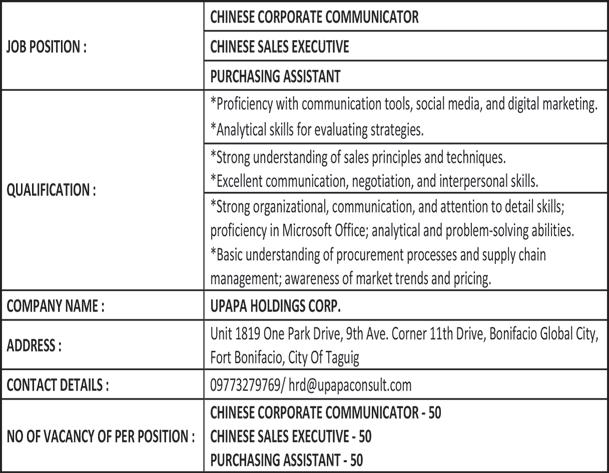



protect...especially our fisherfolk in the West Philippine Sea,” he said. “We will support the President’s pronouncement.”
Gonzales echoed Dalipe’s sentiments, stating that House members, led by Speaker Ferdinand Martin G. Romualdez, have consistently expressed their commitment to increasing the funding for the PCG and the Bureau of Fisheries and Aquatic Resources (BFAR).
“During budget deliberations, we will tackle this issue. I understand that Congressman Jay Khonghun raised this concern, particularly regarding his constituents in Zambales an the West Philippine Sea,” he said.
The allocation for climate change mitigation for 2025 represents a substantial increase of 122.9 percent from the previous year’s allocation of P457.4 billion.
Marcos said the Climate Change Commission (CCC) will receive P170 million to develop policies aimed
at accelerating and localizing the National Adaptation Plan. This initiative will prioritize 18 provinces that are particularly vulnerable to climate change, helping them to implement tailored adaptation strategies.
The Department of Environment and Natural Resources (DENR) has been allocated P1.5 billion for the National Greening Program (NGP), which focuses on the rehabilitation, maintenance, and protection of forests. The NGP aims to plant 7.8 million seedlings across 15,398 hectares of forests and maintain an additional 44,751 hectares.
Additionally, P1.4 billion will be dedicated to the Protected Areas Development and Management Program to protect biodiversity and enhance ecosystem resilience.
National security
TO strengthen the nation’s defense capabilities, the budget for the defense sector has been increased by
50.8 percent, from P278.1 billion in FY 2024 to P419.3 billion in FY 2025. The Department of National Defense (DND) has been allocated P258.2 billion, aimed at acquiring and developing advanced equipment and technologies, as well as deploying adequate manpower to secure the sovereignty of the State and the integrity of the national territory.
The Armed Forces will receive P204.4 billion to support various defense programs. This includes the Land Defense Program with an allocation of P113.3 billion, the Air Forces Defense Program with P46.7 billion, and the Naval Forces Defense Program with P44.4 billion.
These funds are crucial for maintaining and enhancing the country’s defense readiness and capabilities across land, air, and sea domains.
Additionally, the Revised Armed Forces Modernization Program will see a 25 percent boost in its budget, receiving an allocation of P50 billion—an increase of P10
billion from its 2024 FY General Appropriations Act (GAA) allocation. This budgetary enhancement aims to further develop the military’s capacity to uphold the sovereignty and territorial integrity of the country, especially in light of recent developments in the West Philippine Sea.
The Coast Guard will also see a substantial increase in its budget, with an allocation of P31.3 billion. This budget includes funding for several critical projects: the PCG Hospital, with an allocation of P386 million, to improve healthcare services for coast guard personnel; the establishment of the West and South Navigational Telex (NAVTEX) Project, with P452 million, to enhance maritime communication and navigational systems; and the Radar for the Cebu Vessel Traffic Management System, with P37 million, to ensure the efficient and safe management of vessel traffic in Cebu’s waters.
By Lenie Lectura @llectura
THE Philippine National Oil CompanyExploration Corp. (PNOC-EC) and Israel-based Ratio Petroleum Ltd. have completed their respective 3D seismic surveys in the Northwest Palawan Basin and East Palawan Basin, respectively.
The result of the surveys will determine the potential of oil and gas reserves in the basins over the service contract (SC) blocks 76 and 57.
Ratio Petroleum is the operator of SC 76. It holds 100 percent of the rights in the block.
Similarly, PNOC-EC has been awarded a 100-percent interest in SC 57, or an agreement in which the government grants exclusive right to explore, develop or utilize the resources in a particular area. SC 57 covers 7,120 square kilometers in offshore Northwest Palawan, about 50 kilometers northwest of Busuanga.
The Department of Energy (DOE) announced on Tuesday the completion of the offshore 3D seismic surveys. “The completion of these surveys marks a significant milestone in the nation’s petroleum exploration efforts, underscoring the DOE’s commitment to pursuing high impact

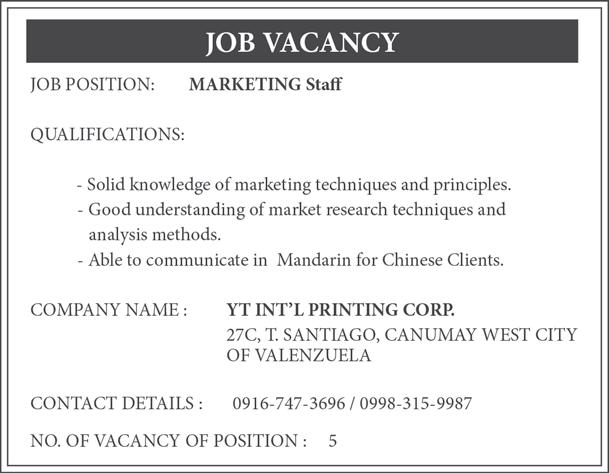
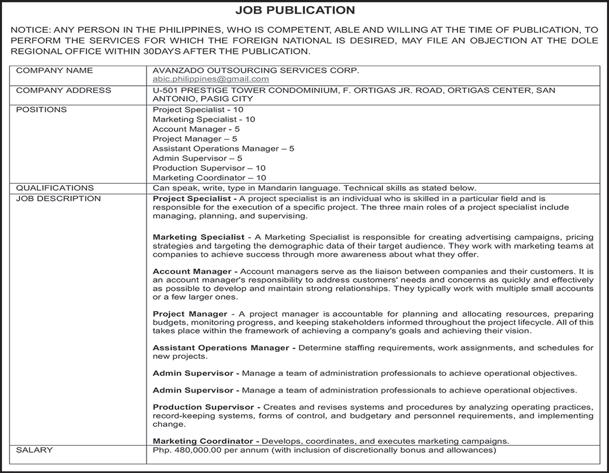
activities to support inclusive economic growth and social advancement,” said Energy Secretary Raphael Lotilla.
The survey, which was conducted from March 18 to June 22 this year, covered 1,619 square kilometers in SC 76 and 1,519 square kilometers in SC 57. Both companies tapped Shearwater GeoServices to deploy the seismic survey vessel SW Thuridur to acquire 3D seismic data over the blocks.
The surveys were approved by the DOE as part of their work commitments in their service contracts. Both work activities were also conducted with the full support of the Provincial Government of Palawan and the
national government agencies, such as the Department of Environment and Natural Resources (DENR) Maritime Industry Authority (Marina), Department of National Defense (DND), National Security Council (NSC), Coast Guard (PCG), Bureau of Fisheries and Aquatic Resources (BFAR), Bureau of Customs (BOC), Philippine Ports Authority (PPA), Bureau of Immigration (BI), Bureau of Quarantine (BOQ), and Palawan Council for Sustainable Development.
Energy Undersecretary Alessandro Sales said it will take one year and six months to process, analyze and evaluate the data from the surveys.



ABILL aimed at regulating motorcyclesfor-hire is on the verge of becoming law after the House of Representatives approved it on its third and final reading on Tuesday. With a vote of 200 in favor, 1 against, and zero abstentions, the House passed House Bill (HB) No. 10424, which authorizes motorcycles to operate as common carriers for the transportation of passengers, goods, parcels, and mail.
“The House of Representatives acknowledges that motorcycles-for-hire not just serve as an efficient alternative to mass public transportation but also a viable source of livelihood for Filipinos,” Speaker Ferdinand Martin G. Romualdez said.
“This bill aims to provide safe, sufficient, and economical mode of public transport by allowing and regulating the use of motorcycles as public utility vehicles,” he added.
HB 10424 mandates the registration of motorcycles-for-hire with the Land Transportation Office (LTO) to ensure their roadworthiness before their registration or renewal of registration.
Once enacted into law, the Land Transportation Franchising and Regulatory Board (LTFRB) will have the authority to regulate the operation of motorcycles-for-hire in areas without operating digital platforms. The number of routes or units allowed to operate will be based on the local public
(LGU).
The bill sets forth requirements for the granting of a franchise or issuance of a Certificate of Public Convenience, which include proof of Filipino citizenship, financial capacity, LTO Certificate of Vehicle Registration, insurance coverage, and a Tax Identification Number or Certificate of Registration as a Common Carrier.
The proposed legislation requires the registration of Motorcycle Taxi Platform Providers (MTPPs) and Online E-commerce Platform Providers (OEPPs) with the Securities and Exchange Commission. It also sets minimum accreditation requirements for these digital platforms.
It also provides a 60 kilometers per hour (60kph) speed limit for motorcycles-for-hire.
LTFRB is tasked to prescribe the fares, surcharges and other transportation fees that may be charged by operators, OEPPs or MTPPs for motorcycle-for-hire services. The fare structure shall be set in consultation with the motorcycles-for-hire industry and subject to the approval of the Department of Transportation.
HB 10424 holds the operator and the MTPP or OEPP jointly and solidarily liable for death, injuries, or damage to property occurred in the course of operating a motorcycle-for-hire, with rights of subrogation against any party at fault.
Jovee Marie N. Dela Cruz
By Malou Talosig-Bartolome
FOREIGN Affairs Secretary En-
rique Manalo said the Philippines and China agreed on an “exchange of information” on the conduct of rotation and resupply (RORE) mission to Ayungin Shoal in the West Philippine Sea.
“On the issue of notification, I think that the more accurate term is ‘exchange of information’ which is exactly what we did with China. Both of us,” Manalo said during the press conference after the 2+2 Ministerial Meeting with US State Secretary Antony Blinken, US Defense Secretary Lloyd Austin III and Philippine Defense Secretary Gilberto Teodoro Jr. Manalo’s statement clarified the issue behind the spat between Manila and Beijing on the terms and conditions that both sides had agreed on to de-escalate tension in the West Philippine Sea.
The Chinese Foreign Ministry had earlier said that they have been “notified” of the RORE mission prior to its deployment. “After confirming on-site
that the Philippine vessel carried only humanitarian living necessities, the Chinese side let the vessel through,” the Chinese MFA spokesman said.
The Philippine DFA said that the Chinese statement “mischaracterized” and “misrepresented” events.
“It is not helpful to keep giving false notions about what has been agreed on and how they were implemented,” DFA Spokesperson Ma. Teresita Daza said.
China winning ‘unthinkable’— Teodoro
AFTER the press conference, BusinessMirror asked Manalo to clarify the timing of the “exchange of information” with regard to the RORE mission. He replied, “It’s gotta be before. Otherwise, what’s the sense of exchanging (information) after?”
Manalo said the understanding also entails China will not block the RORE missions.
“If they said no [to resupply mission], then that’s not part of the understanding,” the foreign affairs chief added. He refused to comment further if
the provisional understanding also included China conducting on-site inspection, as Beijing claims. “Sobra na. Tama na yan. Kaya nga nag-agree [That’s too much. That should be enough; that’s why we had an agreement].”
He added: “And the fact that the resupply was a relative success indicates that it is something we are committed to pursue in the succeeding resupply missions, provided of course that China also adheres to the understanding.”
Despite agreeing to China’s conditions on the RORE mission, the Philippine strategy remains, Manalo and Teodoro stressed.
“The strategy on WPS and SCS never changes. That is to protect our rights, in accordance with the rule of law and Unclos [United Nations Convention on the Law of the Seas],” Manalo and Teodoro said almost in unison.
Both ministers said contrary to what others think, China did not win over the Philippines on the latest Ayungin Shoal deal.
“China winning is the worst, unthinkable scenario,” Teodoro said.
“Do you think we will negotiate if they [China] will win? We will not negotiate to lose,” Manalo interjected. He then added, “It is not win or lose. Let’s just say we had a good RORE.”
US welcomes Ayungin Shoal deal
MANALO and Teodoro briefed their American counterparts about the latest deal in the Ayungin Shoal (international name: Second Thomas Shoal) during the 2+2 Meeting.
Blinken welcomed the provisional understanding between China and the Philippines in the Ayungin Shoal.
“We are pleased to see that the first resupply mission subsequent to that incident went forth without incident. It is important that that be the standard and not the exemption,” Blinken said.
He added that he also spoke about this incident during his bilateral meeting with Chinese Foreign Minister Wang Yi last week in Laos.
“China must uphold its commitments to not

KBy Samya Kullab
The Associated Press
YIV, Ukraine—Russian forces have overrun two front-line villages in Ukraine’s eastern Donetsk region, a Ukrainian army sergeant said Monday, after relentless assaults that are part of a Kremlin summer push to overwhelm battlefield defenses there.
Separately, attacks in Russia’s Kursk region by the Security Service of Ukraine, also known as the SBU, struck a number of substations causing power outages, according to a statement from the General Staff of Ukraine. The claim of responsibility came after Russia said it thwarted a nighttime Ukrainian drone attack.
“They pressed non-stop” to capture Vovche and Prohres, the chief sergeant of Ukraine’s 47th Separate Mechanized Brigade, Oleh Chaus, told Radio Svaboda.
“They sent in a large number of troops, which had not previously been used.”
Russia’s Defense Ministry claimed in recent days that it had taken control of the villages, but the Ukrainian General Staff made no official comment.
The villages lie about 30 kilometers (20 miles) northwest of Avdiivka, a Donetsk city that the Russian army seized in February after a long battle. That victory was the Kremlin’s last major triumph in the war that is now in its third year.
Russia’s onslaught, fueled by its heavy advantage in soldiers and weaponry, has repeatedly forced the Ukrainians to pull back from defensive positions to avoid being captured or killed.
Oleksandr Shyrshyn, the 47th brigade’s deputy battalion commander, confirmed to local media that the villages had been taken. He blamed poor training of troops,

low abilities of officers, motivation and inadequate weapons for the setbacks.
Ukrainian President Volodymyr Zelenskyy late Sunday described the situation in the Donetsk region as “extremely challenging.”
Russia’s strategy of attrition-

al warfare, with powerful glide bombs smashing Ukrainian defenses before infantry move in, has brought incremental gains for the Kremlin as it seeks another big breakthrough. Ukraine is significantly outgunned by Russia’s bigger army on the roughly 1,000-kilometer
(600-mile) front line.
Russian troops are also intensifying their weekslong drive to breach Ukrainian defenses around Pokrovsk, a town of around 60,000 people before the war, the Ukrainian General Staff said Monday.
Russia launched 52 attacks there over the previous 24 hours— almost twice the daily number in recent weeks, it said.
Meanwhile, Russian air defenses thwarted a nighttime barrage of 39 Ukrainian drones over five of the country’s regions, Russian authorities said Monday. Ukraine claimed its forces carried out strikes in the Kursk region.
Russia’s air defense were active and explosions were reported near at least four substations, the statement from Ukraine’s General Staff said. After the attack, power outages were reported in the Ponyrovsky, Solntsevsky and Kursky districtions of Kursk region, according to the statement.
The attacks were carried out by the Security Service of Ukraine’s Special Operations Center, as well as other components of the Defense Forces.
“These facilities, among other things, ensure the functioning of the Russian railway, which transports weapons and military equipment to support its occupation army,” the statement said.
Russia’s Defense Ministry said the drones were “intercepted and destroyed” in regions bordering Ukraine as well as in the Leningrad region roughly 700 kilometers (430 miles) north of the Ukrainian border. A power plant, a bridge and a power line were damaged by drone debris, it said. Ukraine has employed high technology in its campaign of increasingly ambitious drone strikes deep inside Russia that target critical infrastructure in an attempt to make the war more costly for Moscow and hinder its war machine.
Netanyahu vows retaliation after Hezbollah rocket kills 12 children in Golan Heights as
By Leo Correa & Alon Bernstein The Associated Press
MAJDAL SHAMS, Golan Heights—Israeli Prime Minister Benjamin Netanyahu on Monday vowed heavy retaliation against Hezbollah amid furious diplomatic efforts to prevent a spiral into regional war following a weekend rocket strike that killed 12 children in the Israeli-controlled Golan Heights.
Israel has blamed Hezbollah for Saturday evening’s rocket from Lebanon that slammed into a soccer field where the children were playing in the mainly Druze town of Majdal Shams. In an unusual move, Hezbollah denied any role in the strike.
US Secretary of State Antony Blinken spoke with Israeli President Isaac Herzog on Monday, emphasizing the “importance of preventing escalation” and discussing efforts to reach a diplomatic solution to months of conflict.
Israel and the Iranian-backed Lebanese Hezbollah have exchanged fire almost daily over the border since the war in Gaza erupted in October. Each side has seemed intent on avoiding an escalation that would bring their full firepower against each other. But the exchanges have mounted, and the latest strike threatened reprisals and counter-reprisals that could spiral into full-fledged war.
Early Monday, Israeli strikes hit a motorcycle in Lebanon near the border, killing two people and wounding three others, Lebanese state media said. The strikes, mirroring the pace of the daily crossborder fire, did not appear to be Israel’s retaliation for Saturday’s attack.
Thousands of mourners laid to rest on Monday the 12th victim of the strike. The body of 11-yearold Guevara Ibrahim was carried through the streets of Majdal Shams in a procession of blackclad mourners.
Netanyahu spoke as he visited the soccer field
in Majdal Shams and met with leaders of the Druze community.
“These children are our children, they are the children of all of us,” he said as officials laid a wreath on the field. “The state of Israel will not and cannot overlook this. Our response will come, and it will be severe,” he said, adding that the rocket was fired by Hezbollah.
Nearby, around 300 friends, supporters and relatives of the slain children protested against Netanyahu’s visit, shouting that he was exploiting the bloodshed for political gain and calling for an end to the violence. Some held up pictures of the children, saying they wanted no more deaths.
After Netanyahu left, some rushed onto the soccer field and tore down the wreath. Weeping relatives held up toys left by the children on the field.
The Druze of the Golan Heights have long had a fraught relationship with Israel since it captured the territory from Syria in the 1967 war and later annexed it. Some Druze have Israeli citizenship, and ties with Israeli society have grown over the years.
But many still have sympathies for Syria and have rejected Israeli annexation.
Earlier in the day, Defense Minister Yoav Gallant also visited the town, saying Hezbollah will “pay a price” for the attack. He did not elaborate, saying only, “We will let actions speak for themselves.”
Israel’s military says Hezbollah fired an Iranianmade Falaq rocket with a 53-kilogram (117-pound) warhead.
Hezbollah has started moving precision-guided missiles for use if needed, an official with a Lebanese group told The Associated Press, without elaborating on where they are being moved.
The official said Hezbollah’s stance has not changed and it does not want a full-blown war with Israel, but if war breaks out it will fight without limits. The official spoke on condition of anonymity to discuss sensitive military activities.
Israel and Hezbollah have been trading fire since
UK police quiz teenage suspect over attack that left 2 children dead and several critically hurt
By Jill Lawless The Associated Press
LONDON—Police were questioning a suspect and working Tuesday to understand what motivated a 17-year-old boy to attack children at a summer vacation dance and yoga class, leaving two dead and six in critical condition. A total of nine children and two adults were hurt in the rampage in Southport, northwest England. Both adults and six of the children were in critical condition in local hospitals.
“We believe the adults who were injured were bravely trying to protect the children who were being attacked,” Merseyside Police Chief Constable Serena Kennedy said.
Local people left flowers and stuffed animals in tribute at a police cordon on the street lined with brick houses in the seaside resort near Liverpool— nicknamed “sunny Southport”—whose beach and pier attract vacationers from across northwest England. Witnesses described scenes “from a horror movie” as bloodied children ran from the attack just before noon on Monday. The suspect was arrested soon after on suspicion of murder and attempted murder. Police said he was born in Cardiff, Wales and had lived for years in a village about 3 miles (5 kilometers) from Southport. He has not yet been charged. Police said detectives are not treating Monday’s attack as terror-related and they are not looking for any other suspects.
October 8, a day after Hamas militants stormed into southern Israel. Hezbollah has said it is showing its support for the Palestinian group.
More than 500 people, including 90 civilians, have been killed in Lebanon, as have 22 soldiers and 25 civilians on the Israeli side. Tens of thousands have evacuated their homes on both sides of the border.
The US and France for months have pushed for a negotiated agreement between Hezbollah and Israel to quiet the border and allow the return of residents.
The White House National Security Council said it was speaking with Israeli and Lebanese counterparts and working on a diplomatic solution to “end all attacks once and for all” in the border area.
Amos Hochstein, a senior adviser to US President Joe Biden who frequently handles delicate negotiations in Lebanon, has been making a flurry of calls trying to contain the situation, a Lebanese diplomat said, speaking on condition of anonymity because they were not authorize to talk to the press on the issue.
An outright war between Israel and Hezbollah could bring intense destruction. Hezbollah has far superior firepower than Hamas, with an arsenal of 150,000 rockets and missiles, including precisionguided missiles, according to Israeli estimates. The last time they went to war, in 2006, Israel inflicted massive damage in Lebanon with a bombing campaign in retaliation for a cross-border Hezbollah attack. The death and destruction were so great, Hezbollah has been under intense pressure from the Lebanese ever since not to trigger a repeated war with Israel.
Lebanon’s caretaker Prime Minister Najib Mikati spoke to British Foreign Secretary David Lammy. “We both agreed that widening of conflict in the region is in nobody’s interest,” Lammy said in a post on the social media site X.
The Associated Press journalists Bassem Mroue and Abby Sewell in Beirut contributed to this report.
It is the latest shocking attack in a country where a recent rise in knife crime has stoked anxieties and led to calls for the government to do more to clamp down on bladed weapons.
Witnesses described hearing screams and seeing children covered in blood emerging from the Hart Space, a community center that hosts everything from pregnancy workshops and meditation sessions to women’s boot camps.
The attack happened during a Taylor Swiftthemed yoga and dance workshop for children aged about 6 to 11.
“They were in the road, running from the nursery,” said Bare Varathan, who owns a shop nearby. “They had been stabbed, here, here, here, everywhere,” he said, indicating the neck, back and chest.
Prime Minister Keir Starmer called the attack “horrendous and deeply shocking.” King Charles III sent his “condolences, prayers and deepest sympathies” to those affected by the “utterly horrific incident.”
By Candy P. Dalizon Contributor
HAVE you ever wondered what it’s like to live in a community infused with Japanese charm? A haven for modern families, it offers a harmonious blend of nature and community. With thoughtfully planned open spaces and serene gardens, residents will be delighted to enjoy the outdoors together.
Yume at Riverpark invites you to explore the unique experience of a Japanese-inspired neighborhood, nestled within the scenic and progressive province of Cavite.
More than just a name, Yume (meaning dream and vision in Japanese) is the philosophy behind this residential development, crafted with boundless imagination for a life beyond the ordinary. As the inaugural project of Federal Land NRE Global Inc. (FNG) in Cavite, Yume at Riverpark offers families a nurturing environment, providing the perfect space to build a thriving future.
FNG is a powerhouse joint venture between Federal Land Inc. and Nomura Real Estate Development Co., Ltd., two real estate giants in the Philippines and Japan. FNG brings innovation to life with its exceptional residential homes, commercial spaces, modern office buildings, and integrated urban enclaves in major Philippine cities.
Spanning across 18 hectares of land, Yume at Riverpark emerges as a vast horizontal residential area situated within Riverpark - Federal Land’s master-planned community in General Trias, Cavite. It effortlessly blends urban conveniences with suburban tranquility.
Yume at Riverpark’s upscale amenities YUME at Riverpark offers 296 lots ranging from 300 to 527 square meters. Its upscale amenities turn everyday moments into mindful experiences.
The village Clubhouse showcases a successful collaboration between Filipino (Ar. Ed Calma) and Japanese architects (UDS Japan). Expect a design that blends elegance and functionality, true to Japanese design principles.
Every detail of Yume at Riverpark has been meticulously planned to create a living environment that blends seamlessly with nature. From the expansive central park to the lush green spaces, tranquil fitness areas, and winding pathways, every element
is crafted to nurture an environment that promotes a balanced and vibrant lifestyle. Yume at Riverpark offers refreshing amenities for relaxation, rejuvenation, and recreation.
For indoor activities, residents can enjoy a lounge, function room, multipurpose hall, and a wellness spa complete with a jacuzzi and sauna.
Yume at Riverpark offers a haven of outdoor amenities too, featuring a swimming pool, charming pocket parks, a dedicated kids' zone, invigorating fitness areas, a versatile multipurpose court, expansive open lawns, and a tranquil Japanese garden.
Each pocket park features fitness stations, catering to a range of active lifestyles, from morning joggers to yoga enthusiasts.
Yume at Riverpark goes beyond aesthetics. Design features, integrated behind the scenes, elevate everyday living and focus on improving functionality,and residents’ comfort, all contributing to an unparalleled living experience. Among these are enhanced security, hybrid utilities, and the preservation of majestic trees, honoring the site’s natural heritage and maintaining a connection to its history.
Yume at Riverpark’s security system ensures that only authorized residents can access the premises, providing security and exclusivity for residents. Yume at Riverpark likewise employs a smart approach to utilities, with below-ground installations on the main road for an unobstructed view, and overhead power lines on secondary roads for efficient service.
This Japanese-inspired horizontal development is slated for completion in May 2026.
Riverpark: Next Gen City of the South WHERE can one find this unique, Japanese-inspired nurturing community?
Yume is located within the Riverpark Community, a vibrant 600-hectare township in General Trias, Cavite. Cavite is emerging as a major real estate hub. Discerning homebuyers will find a diverse

selection of residential projects that cater to their unique needs and aspirations.
Riverpark is designed to offer smart living and lifestyleenhancing developments in a setting that seamlessly combines river and park side experience. It is a self-sustaining community that promotes holistic living by carefully crafting a comprehensive array of amenities and infrastructure. Residents will have access to a wide range of conveniences and recreational opportunities, all just a short stroll away.
Aside from a diverse range of residential options, Riverpark provides dedicated space for commercial enterprises, educational institutions, and healthcare facilities, alongside modern office spaces. This vibrant mix cultivates a fertile ground for personal and professional growth.
Riverpark is highly accessible and connected to major Metro Manila CBDs (Makati and BGC) through various existing and
upcoming infrastructure projects. It is 50 minutes away from Ninoy Aquino International Airport via NAIAX and CAVITEX; an hour away from the Mall of Asia via CAVITEX; also an hour away from Makati CBD via Skyway and MCX, and 40 minutes away from Alabang via Daang Hari Road.
Among the upcoming infrastructure projects in the vicinity are Cavite-Laguna Expressway (CALAX), LRT Line 1Extension, LRT Line 6A – Cavite Extension, Cavite-TagaytayBatangas Expressway (CTBEX), Bataan-Cavite Interlink Bridge, and Sangley Point International Airport.
Riverpark's central location offers residents easy access to everything that matters –workplaces, schools, healthcare, and exciting leisure destinations.
In June alone, significant developments unfolded at Riverpark in General Trias. SM City General Trias, a large-scale regional mall, commenced construction

with a groundbreaking ceremony, promising generous shopping options, expansive outdoor spaces for an active lifestyle, and plans for future expansion. Concurrently, a new UNIQLO logistics facility is set to rise in Riverpark, marking it as the company's latest central hub. This human-centric warehouse is expected to create numerous job opportunities, contributing to the region's economic vitality. These milestones underscore General Trias's ongoing growth, with major brands like SM and UNIQLO choosing Riverpark as their strategic locations, signaling the city's dynamic trajectory.
Filipino vision meets Japanese innovation AT FNG, people come first. FNG is passionate about creating possibilities and igniting excitement for life's potential. It takes a comprehensive approach to understand people’s needs. By skillfully blending Japanese design
and innovation with Filipino sensibility, FNG strives to build sustainable urban communities that foster thriving families. Boasting a legacy of 50 years, Federal Land, Inc. (FLI), a real estate arm of GT Capital Holdings and a valued ally of the Metrobank Group, has excelled as a premier Philippines developer. Renowned for iconic residential condominiums, office buildings, retail and commercial centers, mixed-use townships, and master-planned communities, FLI persistently shapes the Philippine real estate landscape.
Nomura Real Estate Development Company, Ltd (NRE), a subsidiary of Nomura Holdings, Inc., has positioned itself as a prominent Japanese real estate developer for over 65 years. With resolute dedication to progress, NRE has broadened its influence in diverse domains encompassing residential projects, office spaces, retail centers, logistics hubs, and corporate real estate. For more information on FNG and its projects, visit www.fng.ph.


By Dake Kang The Associated Press
TAIPEI, Taiwan—Taiwanese President Lai Ching-te welcomed what he called the “largest-ever” delegation of foreign lawmakers to Taiwan and said Tuesday it showed the importance of democracies uniting, even as Beijing pressured members of the delegation not to visit.
“This demonstrates the support and the value various other countries place on Taiwan,” Lai said. “It also sends an important message to democratic countries around the world. Maintaining democracy requires unity, and we must protect democracy together.” Lai made his remarks at a conference in Taipei held by the InterParliamentary Alliance on China, a group of hundreds of lawmakers from 35 countries concerned about how democracies approach Beijing.

the statement said.
Lai, also known by his English name William, is reviled by Beijing for his staunch opposition to political unification with the mainland. Earlier in his career, Lai said he was a “pragmatic worker for Taiwan independence,” but has since softened his rhetoric, saying he supports maintaining the status quo across the Taiwan Strait.
Beijing prevents countries it has diplomatic relations with from having formal ties with Taipei.
China has been peeling off the island’s diplomatic allies, often with promises of development aid, in a long-running competition between the two that has swung in Beijing’s favor in recent years.
“hardcore” Taiwan independence supporters. In response, Taipei urged its citizens to avoid traveling to China and the semi-autonomous Chinese territories of Hong Kong and Macao.
Beijing sees Lai as a separatist and refuses to speak with him. China has ramped up pressure against the island since Lai took office in May, sending ships and planes on a large military drill to show displeasure at his inauguration. That comes after years of Beijing’s pressure on Taiwan—which has been ruled by the DPP for three terms now—on diplomatic, military and economic fronts.
Lai said at the conference that Taiwan would work with other democracies to protect democracy from “the threat of authoritarian expansionism.”
Beijing views the self-governed island democracy as part of its territory and has been upping its threats to annex it by force if necessary. Lai’s party, the Democratic Progressive Party, doesn’t seek independence from China because he believes that Taiwan is already a sovereign nation.
calls
“China’s threat to any country is a threat to the whole world,” Lai told conference participants. China “uses diplomatic kidnapping, economic coercion, internet attacks, and spreading false and fake things to continuously muddle matters and seek to undermine regional peace and stability.”
Lai’s comments come as IPAC is under renewed scrutiny from Beijing. Lawmakers from at least six countries told The AP earlier this week that Chinese diplomats were pressuring them not to attend the conference, in what they described as efforts to isolate the
self-governed island.
The Chinese government has long despised IPAC: Some members have been sanctioned by Beijing, and in 2021 the group was targeted by Chinese state-sponsored hackers, according to a US indictment unsealed earlier this year.
In a written statement, the Chinese Foreign Ministry said IPAC “has no credibility at all” and repeated its stance that Taiwan is part of Chinese territory.
“China firmly opposes any form of official exchanges between countries with diplomatic ties with China and the Taiwan authorities,”
pact ‘destabilizing’ and ‘risky for the world’
By Hyung-Jin Kim
The Associated Press
SEOUL, South Korea—Australia’s foreign minister said Tuesday the recent defense
deal between North Korea and Russia was “destabilizing” and “risky for the world,” after she visited the tense border village shared by North and South Korea on Tuesday.

In June, North Korean leader Kim Jong Un and Russian President Vladimir Putin signed a pact stipulating mutual military assistance if either country is attacked, deepening worries about the expanding ties between the countries. The US and its partners have steadfastly accused North Korea of supplying much-needed conventional arms to Russia for its war in Ukraine in return for military and economic assistance.
“I also want to say something about the security pact between North Korea and Russia. And say again, this is destabilizing. This is risky for the world and again we say Russia is behaving in ways which are not conducive to peace but are escalatory,” Australian Foreign Minister Penny Wong told reporters following a visit to the southern side of the Korean border village of Panmunjom.
Wong condemned North Korea’s extended run of missile tests that she said threaten regional security. “We share great concerns about DPRK’s escalatory
reactions, destabilizing actions,” she said, referring to North Korea by the acronym of its official name, the Democratic People’s Republic of Korea.
Also Tuesday, Wong met South Korean Foreign Minister Cho Tae-yul in Seoul and agreed to work together with the international community to cope with the North Korean-Russian military partnerships. The two also agreed to strengthen bilateral cooperation on economic security, climate change and other areas, according to South Korea’s Foreign Ministry.
Tensions on the Korean Peninsula have been running high in recent months, with North Korea flying trash-carrying balloons toward South Korea and continuing weapons tests. South Korea has responded by resuming anti-Pyongyang propaganda broadcasts and live-fire drills at border areas.
The Associated Press video journalist Kim Yong Ho contributed to this report from Paju, South Korea.
The Pacific Island nation of Nauru switched recognition to Beijing earlier this year, a move that reduced Taiwan’s dwindling number of diplomatic allies to 12.
Since Lai took office in May, tensions have continued to simmer in the region.
The US has been aiding in the upgrading of Taiwan’s equipment and training, with the US State Department approving the sale to Taiwan of missiles and drones for an estimated $360 million last month. In April, the House of Representatives approved an $8 billion military aid package for Taiwan.
In late June, Beijing’s top court issued guidance saying the death penalty could be used against
Top diplomats from the US, Japan, India and Australia met in Tokyo this week to discuss security issues in the Indo-Pacific region, shortly after the US and Japan held their “2+2” security meeting Sunday, where they called China “the greatest strategic challenge.” High on the agenda were Taiwan and cross-strait relations. Beijing’s escalating assertiveness in the South China Sea has triggered tensions with many neighbors, adding to fears of a confrontation. Lai has vowed to continue maintaining stability with China while beefing up Taiwan’s security by importing military equipment, expanding its defense industry, and reinforcing regional partnerships with unofficial allies such as the US, Japan, South Korea and the Philippines.
“We are willing to replace confrontation with dialogue and containment with exchanges under the principles of reciprocity and dignity,” Lai told participants. “We will communicate with China to reduce conflicts and achieve peace and stability in the Taiwan Strait.”
The Associated Press journalist Johnson Lai contributed to this report.
North Korean officials seek medicine for Kim’s health problems related to obesity, Seoul says
By Hyung-Jin Kim The Associated Press
SEOUL, South Korea—North Korean leader Kim Jong Un has regained weight and appears to have obesityrelated health problems such as high blood pressure and diabetes, and his officials are looking for new medicines abroad to treat them, South Korea’s spy agency told lawmakers Monday.
The 40-year-old Kim, known for heavy drinking and smoking, comes from a family with a history of heart problems. Both his father and grandfather, who ruled North Korea before his 2011 inheritance of power, died of heart issues.
Some observers said Kim, who is about 170 centimeters (5 feet, 7 inches) tall and previously weighed 140 kilograms (308 pounds), appeared to have lost a large amount of weight in 2021, likely from changing his diet. But recent state media footage shows he has regained the weight.
On Monday, the National Intelligence Service, South Korea’s main spy agency, told lawmakers in a closed-door briefing that Kim is estimated to weigh about 140 kilograms (308 pounds) again and is in a high-risk group for heart disease, according to Lee Seong Kweun, one of the lawmakers.
Lee said the NIS told lawmakers that Kim has shown symptoms of high blood pressure and diabetes since his early 30s. Another lawmaker, Park Sunwon, said the NIS believes Kim’s obesity is linked to his drinking, smoking and stress.
Lee and Park quoted the NIS as saying it obtained intelligence that North Korean officials have been trying to get new medications abroad for Kim’s suspected high blood pressure and diabetes. North Korea is one of the most secretive countries in the world, and there is virtually no way for outsiders to know Kim’s exact health conditions. The NIS also has a spotty record in confirming developments in North Korea.
Kim’s health is the focus of keen attention outside North Korea since he hasn’t formally anointed a successor who would take charge of the country’s advancing nuclear arsenal targeting the United States and its allies if he was incapacitated.
The NIS in its Monday briefing maintained its assessment that Kim’s preteen daughter, reportedly named Kim Ju Ae, is bolstering her likely status as her father’s heir apparent. But the NIS said it cannot rule out the possibility that she could be replaced by one of her siblings because she hasn’t been officially designated as her father’s successor.
By Sheikh Saaliq The Associated Press
EW DELHI—Multiple landslides triggered by torrential rains in southern India have killed 49 people, and many others are feared trapped under the debris, officials said Tuesday, with rescue operations being hampered by bad weather.
The landslides hit hilly villages in Kerala state’s Wayanad district early Tuesday and destroyed many houses and a bridge, but authorities have yet to determine the full scope of the disaster. Rescuers were working to pull out people stuck under mud
and debris, but blocked roads and unstable terrain hampered their efforts.
P M Manoj, press secretary to the Kerala chief minister, said the landslides had killed at least 49 people so far. Local media reported that most of the victims were tea estate workers.
Television footage showed rescue workers making their way through mud and uprooted trees to reach those who had been stranded. Vehicles swept off the roads were seen stuck in a swollen river.
Authorities mobilized helicopters to help with rescue efforts and the Indian army was roped in to build a temporary bridge after landslides destroyed a main bridge that linked
the affected area.
“We are trying every way to rescue our people,” state Health Minister Veena George said. In a post on social media platform X, Indian Prime Minister Narendra Modi said he was “distressed by the landslides in parts of Wayanad,” a hilly district which is part of the Western Ghats mountain range.
“My thoughts are with all those who have lost their loved ones and prayers with those injured,” Modi wrote. He announced compensation of $2,388 to the victims’ families. India’s weather department has put Kerala on alert as incessant rains have lashed the state. Downpours have disrupted life
for many, and authorities closed schools in some parts Tuesday. More rains are predicted through the day. Kerala, one of India’s most popular tourist destinations, is prone to heavy rains, flooding and landslides. Nearly 500 people were killed in the state in 2018 in one of the worst floods.
The Indian Meteorological Department said the state has had heavy rainfall over its northern and central regions, with Wayanad district recording up to 28 centimeters (11 inches) of rain in the past 24 hours.
AP writer Sibi Arasu in Bengaluru, India, contributed to this report.
Editor: Francine Medina
IN his third State of the Nation address delivered on July 22, President Ferdinand Marcos Jr. highlighted the tourism industry as among the country’s economic pillars. Emphasizing the need for a multifaceted strategy amid postpandemic recovery, he said the focus is now shifting towards offering experiential tourism rather than on merely offering destinations.
As a response to the President’s message, Department of Tourism (DOT) Secretary Christina Garcia Frasco, expressed her office's commitment to further promote various experiences to tourists and veer away from the One Town, One Product (OTOP) framework. The more experiences, the better, President Marcos said in his speech. According to Secretary Frasco, “I agree with the President’s pronouncement that “the tourism challenge has already evolved and now requires a multifaceted strategy” and that “we shall



interpose the wholesome and hospitable Filipino brand in all the key tourism touchpoints, from tourist arrival to departure.”
The DOT secretary further mentioned that the focus on experiential tourism is being activated through the National Tourism Development Plan 2023 to 2028, which includes the Philippine Experience Program with key components such as the Philippine Eatsperience, The Filipino Brand of Service Excellence Training Program, Tourist Rest Areas. She added that the program likewise includes specialized tourism
segments such as Dive Tourism, Gastronomy Tourism, Cruise Tourism, and Halal Tourism, among others.
In this edition of Regions, the spotlight is on Bohol, Cebu, and Boracay in the Visayas. Three destinations that have been earning accolades and notable mentions in the international travel industry. Renowned for their respective natural, cultural, and agricultural attractions, gastronomic offerings, and rich heritage, these major locations are also stepping up to the new tourism challenge with new digital and physical infrastructure to boost services and enhance the tourist experience.
The DOT secretary also mentioned that in 2023, data from the Philippine Statistics Authority, the country's tourism industry had a recordbreaking 8.6% share in the gross domestic product (GDP), which was the highest growth rate in Tourism Direct Gross Value Added in 24 years. She added, “Total inbound and domestic visitor receipts totaled Php 3.367 trillion showing an over 100% recovery of 2019 receipts and a remarkable 75.3% increase from 2022. Most importantly, Tourism generated 6.21 million jobs for Filipinos.” —Francine Medina




There's more to Cebu than its dynamic city and beautiful beaches. Two quaint towns, Argao and Dalaguete, await travelers to explore its cultural treasures, culinary delights, fine crafts, and more.


By Edwin P. Sallan
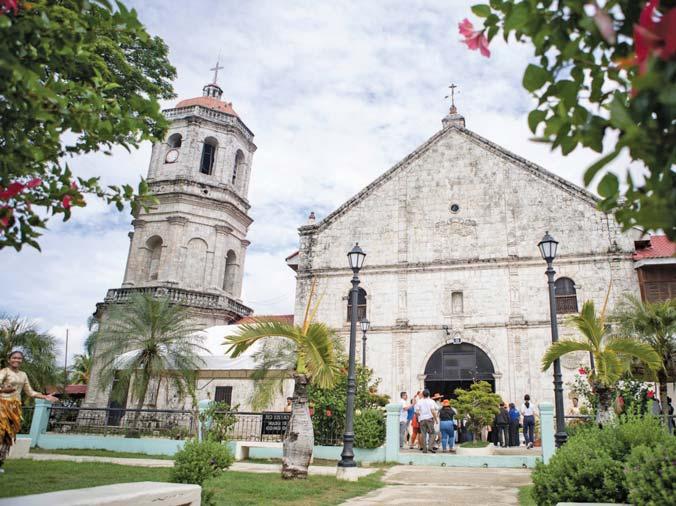

LAST June the Province of Cebu hosted the first-ever UN Tourism Regional Forum on Gastronomy Tourism for Asia and the Pacific. While the event was the perfect opportunity to promote gastronomy tourism in the Philippines, it was also an ideal occasion for attendees— our media contingent included—to get to know parts of the province that not too many visitors are familiar with.
On our second day, we were given the chance to choose between three Cultural and Heritage Tours organized by the Department of Tourism (DOT) in partnership with the Provincial Government of Cebu. Some opted for the enchanting Camotes Island Escapade while others decided to go with the Alonguisan River EcoCultural Tour.
Our media group opted for the cultural treasures and culinary finds of the quaint and laidback towns of Argao and Dalaguete. Both are known for their storied histories as evidenced by their Spanish colonial structures, remarkable crafts, traditional dances, and yes, culinary delights.


Dalaguete, the Vegetable Basket of Cebu First stop that morning was Dalaguete, the southernmost municipality dubbed as the Vegetable Basket of Cebu because of its Dalaguete Vegetable Terraces that consisted of rows upon rows of vegetables cascading down the mountainside.
Our brief visit, however, began with a visit to the historic San Guillermo de Aquitania Parish Church or simply known as the Dalaguete Church. Officially hailed as a National Cultural Treasure only this year, the grand structure’s construction began way, way back in 1802, and was fully completed many years later in 1825 completed in 1825.


Characterized by intricate colonial architecture, majestic painted ceilings, and religious artifacts, the church’s special features include the ruins of the Spanish Watchtower that silently guarded the coastline for centuries and the Dalaguete Heritage Museum, which shows how Dalaguete has evolved from a pre-colonial sleepy town to a progressive agricultural center that continues to flourish to this day.
Following our museum tour, we proceeded to the nearby Dalaguete Town Plaza where we were warmly welcomed by Cebu Governor Gwendolyn Garcia. We were treated to some cultural performances of local artists and a generous buffet of local specialties that included kinilaw na isda, sinugbang liempo, sinugbang pusit, tinolang bisayang manok , and yes, the extremely popular Cebu lechon. Other refreshing treats also included fresh fruit juices and halo-halo.
Dalaguete's culinary scene is a reflection of its agricultural identity. Fresh seafood dishes like sinugba (grilled seafood) or kinilaw (the local version of ceviche) as well as unique delicacies like ginamos (shrimp paste) and puso (boiled rice inside woven coconut leaves) all capture the essence of Cebu’s gastronomic appeal.
Argao’s history and traditions
Up next was Argao, another coastal municipality, which is located in Cebu’s southeastern pocket. In welcoming our presence, Argao Mayor Allan Sesaldo and other locals happily put on hablon scarves around our necks. Crafted by locals through hand-looming techniques, hablonweaving remains a popular tradition identified with Argao in Cebu.
Whether one is a history buff or not, it’s hard not to marvel at
Argao's well-preserved Spanish colonial architecture, which is best exemplified by the St. Michael Archangel Parish Church. Also known as the Archdiocesan Shrine of San Miguel Arcangel, the breathtaking Baroque structure and important heritage landmark dates back to 1788. Intricate carvings and frescoes adorn the facade while interiors are known for its jaw-dropping painted ceilings. The somber sound of its pipe organ adds to the historic appeal.
Governor Garcia welcomed the delegates in Dalaguete and likewise joined our group in Argao to lead the tour of the place. local specialties prepared by participating interactive booths set up by the Municipalities of Argao, Alcoy, and Boljoon. There were live demonstrations of hablon weaving and puso and torta-making. Not to be confused with the omelet viand torta, Argao’s torta is a local cake made from egg and fermented coconut milk. Other Argao specialties that we also got to sample in this town include Argao Native Chicken, Pinaisan Nga Imbaw, Humba de Argao, Binignit, Sikwate and Kinilaw nga Balat ng Isda, Binignit, and Sikwate Aside from the fresh seafood dishes that are considered staples in this coastal town, there’s also the quintessential Lechon Cebu, a mustindulge on every visit to Cebu. All told, there’s a lot more to Cebu than the usual cities and tourist spots. In addition to its three





By Edwin P. Sallan
WITH its pristine beaches, popular resorts, natural wonders (those adorable tarsiers come to mind), and soughtafter tourist spots, Bohol has long been considered a viable alternative to Boracay, especially during the summer months when the latter often becomes too crowded for comfort.
Early this year, however, the 10th largest island in the Philippines made headlines due to sudden construction of a resort nestled at the foot of one of the famous Chocolate Hills. Largely overshadowed by this controversy are the strides Bohol continues to make in the thriving trend of farm tourism.
Just last February, the Provincial Government of Bohol hosted the resumption of the Philippine Farm Tourism Conference set at The Bellevue Resort in Bohol’s Panglao Island. Now

on its 7th edition, the international event was organized by the International School of Sustainable Tourism (ISST) and supported by the Southeast Asian Regional Center for Graduate Study and Research in Agriculture (SEARCA) based in Los Baños, Laguna. Former Tourism secretary and current ISST president Mina Gabor noted that this year’s edition of the conference with the theme, “Farm Tourism: Consciousness for Healthy Living and New Experiences” opted to focus on sustainable growth through the cultivation of fruit and vegetable farms, aquaculture and artisanal fisheries, and green investments in farm tourism. Among the events that took place during the confab included a DTI -led exhibit of agricultural produce and by-products under its One Town One Product program, and a farm tour of notable farm tourism sites like Loboc Cacao Farm, Kinaiyahan Forest Park in Bilar, Asin

Tibuok makers in Alburquerque, Lasang Cacao Farm in Maribojoc, Green Thumb Farm in Corella, South Farm in Panglao, Bohol Bee Farm in Dauis, Manay’s Farm in San Miguel, Ubay Dairy Farm, and Jagna Recycling Facility and Eco Farm.
Delegates of the confab were also given a tour of the province’s iconic attractions such as the Tarsier Sanctuary in Corella and yes, the Chocolate Hills Park in Carmen.
Farm tourism is a unique travel experience that allows visitors, especially tourists to not only bond with nature but also to learn about local agriculture. For tourists, farm tourism means contributing to a more responsible industry by immersing in Bohol’s sustainable practices. A good number of farms in the province focus on organic farming, eco-friendly methods, and responsible waste management.
It also means going beyond the usual sightseeing trips by engaging in farm activi-
ties like planting crops, harvesting fruits and vegetables, or even learning traditional food production methods. While visitors will literally get their hands dirty, they will also gain a deeper appreciation on how most of their favorite food found their way to their respective tables.
As farms are often family-run businesses thriving with local tradition, learning about the Boholanos’ way of life will also lead to a more profound understanding of Bohol’s culture.
Diverse farm tourism experiences
The best thing about Bohol’s farm tourism industry is its diversity. Those who wish to learn about organic farming practices, participate in planting and harvesting activities, and enjoy meals prepared with fresh, organic ingredients should consider visiting the Green Thumb Farm in Corella or the Maribojoc Organic Demo Farm.
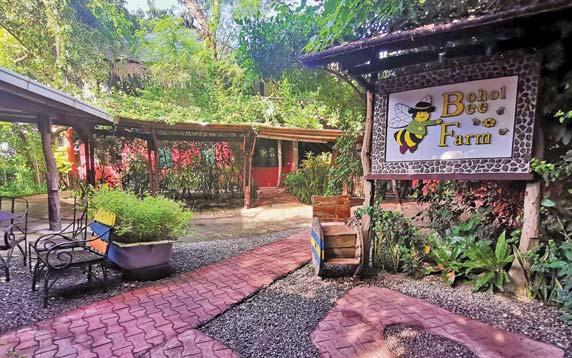
Although the most popular tourist spot in Bohol, the Chocolate Hills, has very little to do with real chocolates, it’s not really surprising that Bohol is also known for its cacao farms.
Dropping by the Loboc Cacao Farm or the Lasang Farm and Camp will let visitors discover the bean-to-bar process, participate in chocolate workshops, and of course, indulge in those delicious chocolate treats.
For a literal taste of honey, there’s also the Bohol Bee Farm where visitors can learn about honey production, the intricate beehive ecosystem, and various honey products that anyone can sample.
Livestock farms like the Ubay Dairy Farm or Manay’s Farm in San Miguel await those who yearn for “the simple life” and a more traditional farming experience that includes interaction with farm animals.
Finally, eco-farms like the Bung-aw Eco Farm in Clarin, known for responsible waste man-
agement and commitment to ecological balance, underscore sustainable practices in farming.
The 7th Philippine Farm Tourism Conference was also an opportunity to recognize the leading advocates and champions of Asia’s growing farm tourism industry through the prestigious Lakbay Bukid Awards. With a US$ 1,000 cash prize from the family of the late tourism stalwart Bobby Joseph, the award was first given in 2016 to individuals, institutions and



you’ll find utmost relaxation, whether you’re traveling for business or leisure. The contemporary Filipino interiors are a mixture of elegance and warmth, and designed to make you feel right at home. Get incredible views of the sea or the city skyline and all the space you could
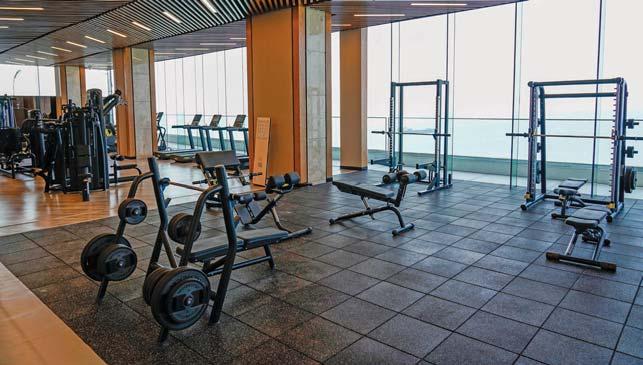
view—a true paradise. Fili Hotel is a celebration of the Philippines’ heritage and pride, with evidence of Filipino creativity and craftsmanship throughout the property, from the use of solihiya at the Fili Lobby Lounge to furniture by Vito Selma and artworks by Jef Albea and Fidel Sarmiento. It’s the Fili hallmark—a distinct luxurious experience enriched by Filipino culture and the local way of life, from its signature malasakit and magiliw brand of genuine care and friendly service to its awardwinning architecture and design.
Dining options
Good food is a must for every traveler and at Fili Hotel, guests are spoilt

for choice. There’s Fili Cafe, a buffet restaurant which features a vast array of dishes and cuisines to choose from, and even a live roasting station. Fili Cafe is a great place to indulge in international flavors and also local favorites like the popular Cebu lechon and sutukil. For an opulent treat, try the Sunday brunch, which promises endless gustatory delights including lobsters cooked just the way you like. Then of course, there’s the world-famous Mott 32 from Hong Kong, the only Mott 32 in the Philippines, which is also inside NUSTAR Resort and Casino and mere steps away from Fili Hotel. This award-winning Chinese restaurant is widely recognized for
serving “the best Peking duck in Hong Kong,” and is celebrated for its many other delightful dishes including the Barbecue Iberico Pork with Yellow Mountain Honey; Wokfried Lobster with Crispy Potato, Salt and Pepper; Prawn, Crispy Rice Paper and Asparagus Cheung Fun; and Sauteed String Beans with Diced Australian Wagyu Beef. Not to be missed as well are Mott 32’s delicious signature cocktails like Forbidden Rose, Jade Road and Hanami. There’s also the Fili Lobby Lounge (open daily from 8 a.m. to 11 p.m.) at the ground floor of the hotel which serves salad shakers, sandwiches, pastries, desserts, good coffee, cocktails, mocktails and other drinks. Try the FILIpiniana, a delightful mix of vodka, coconut juice, lychee fruit, lychee syrup and lemon juice or the Dulce de Fili (espresso, white chocolate, salted caramel, vanilla and fresh milk). Order the Lechon Empanada,



The world-famous island's tourist-friendly status examined with growing concerns over access fees and facilities
By John Eiron R. Francisco
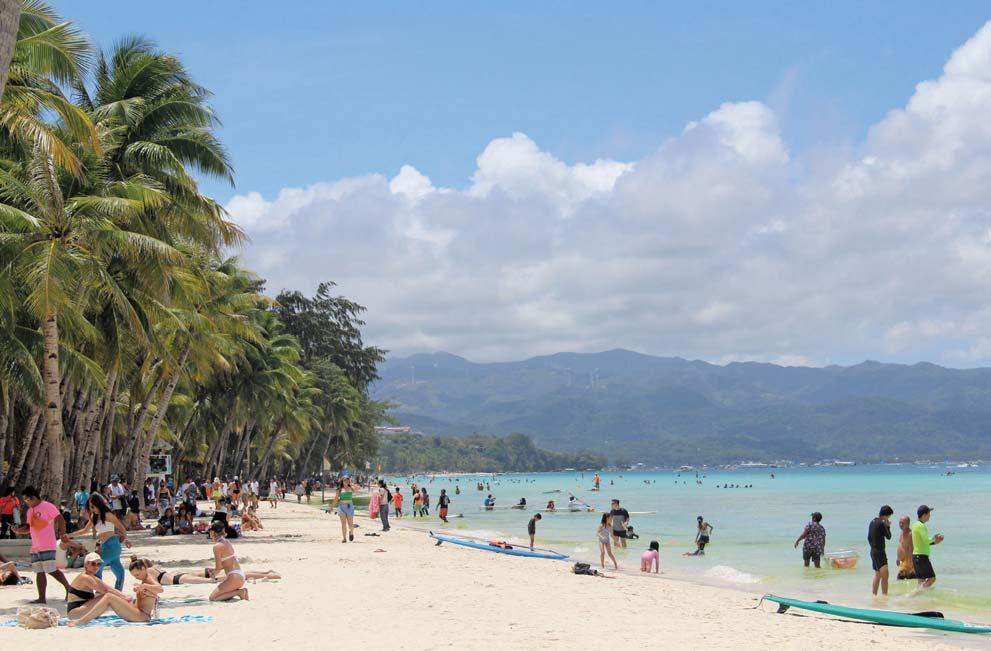

By Matt O’brien & Sarah Parvini Ap Technology Writers
TWO days after President Joe Biden signed a sweeping executive order on artificial intelligence last year, Vice President Kamala Harris brought the wonky document to a global AI summit, telling an international audience what set the US apart in its approach to AI safety.
In an event meant to address the potential catastrophes posed by futuristic forms of AI, Harris made waves by pivoting to presentday concerns—and the need to codify protections quickly without stifling innovation.
“When a senior is kicked off his healthcare plan because of a faulty AI algorithm, is that not existential for him?” Harris told a crowd in London last November.
“When a woman is threatened by an abusive partner with explicit deepfake photographs, is that not existential for her?”
Now, she’s running for president and her chief opponent, former President Donald Trump, has said he wants to “cancel” the Biden order. Trump’s running mate, Ohio Sen. JD Vance, also brings his own views on AI, which are influenced by his ties to some Silicon Valley figures pushing to limit AI regulation.
AI’s growing visibility in everyday life has made it a popular discussion topic but hasn’t yet elevated it to a top concern for American voters. But this could be the first presidential election where the candidates are crafting competing visions on how to guide American leadership over the fast-

developing technology. Here are the candidates’ records on AI:
Trump’s approach BIDEN signed his AI executive order last October 30, and soon after Trump was signaling on the campaign trail that, if re-elected, he’d do away with it. His pledge was memorialized in the platform of this month’s Republican National Convention.
“We will repeal Joe Biden’s dangerous Executive Order that hinders AI Innovation, and imposes Radical Leftwing ideas on the development of this technology,” says Trump’s platform. “In its place, Republicans support AI Development rooted in Free Speech and Human Flourishing.”
The Trump campaign didn’t respond to a request for more details.
Trump didn’t spend much time talking about AI during his four years as president, though in 2019 he became the first to sign an executive order about AI. It directed federal agencies to prioritize research and development in the field.
Before that, tech experts were pushing the Trump-era White House for a stronger AI strategy
to match what other countries were pursuing. In 2017, not long before Google quietly introduced a research breakthrough helping to set the foundation of the technology now known as generative AI, then-Treasury Secretary Steven Mnuchin brushed aside concerns about AI displacing jobs, saying that prospect was so far in the future that “it’s not even on my radar screen.”
That perspective later shifted, with Trump’s top tech adviser telling corporate leaders in 2018 that AI-fueled job displacement is “inevitable” and that “we can’t sit idle, hoping eventually the market will sort it out.” The 2019 order called on federal agencies to “protect civil liberties, privacy and American values” in applying AI technologies, and to help workers gain relevant skills.
Trump also in the waning weeks of his administration signed an executive order promoting the use of “trustworthy” AI in the federal government. Those policies carried over into the Biden administration.
Harris’ approach
THE debut of ChatGPT nearly halfway through Biden’s presidential term made it impossible for politicians to ignore AI. Within months, Harris was convening the heads of Google, Microsoft and other tech companies at the White House, a first step down a path that brought leading developers to agree to voluntary commitments to ensure their technology won’t put people’s rights and safety at risk.
Then came Biden’s AI order, which used Korean War-era national security powers to scrutinize high-risk commercial AI systems but was mostly directed at safeguarding the government’s use of the technology and setting standards that could foster commercial adoption. Unlike the European Union, however, the US still has no broad rules on AI—something that would require Congress to pass.
Harris already brought to the White House a deep understanding of Silicon Valley, having grown up and worked in the San Fran-
cisco Bay Area and later served as California’s attorney general, where she forged relationships with some tech leaders, said Alondra Nelson, former director of the White House Office of Science and Technology Policy.
Even before ChatGPT, Nelson led the White House efforts to draft a blueprint for an AI “bill of rights” to guard against the technology’s potential harms. But it was the speech at the Global Summit on AI Safety in London where Harris brought all those threads together and “articulated to the world what American AI strategy was,” Nelson said.
Harris said she and Biden “reject the false choice that suggests we can either protect the public or advance innovation.” And while acknowledging a need to consider existential threats to humanity, Harris emphasized “the full spectrum of AI risk.”
“She kind of opened the aperture of the conversation about potential AI risks and harms,” Nelson said.
Vance and the VCs TRUMP’S pick of the former venture capitalist Vance as running mate added a new element to the differences between the campaigns. So did Trump’s newfound endorsements from a group of AI-focused tech leaders including Elon Musk and the venture capitalists Marc Andreessen and Ben Horowitz.
Vance has acknowledged some harmful AI applications, but said at a July Senate hearing that he worries that concern is justifying “some preemptive overregulation attempts that would frankly entrench the tech incumbents that we already have.”
Andreessen, who sits on the board of Meta Platforms, has criticized a provision of Biden’s order that requires government scrutiny of the most powerful and ostensibly risky AI systems if they can
perform a certain number of mathematical calculations per second. On a podcast with business partner Horowitz explaining their support of Trump, Andreessen said he was concerned with “the idea that we’re going to deliberately hamstring ourselves through onerous regulations while the rest of the world lights up on this, and while China lights up on this.”
Horowitz read aloud the RNC call to repeal Biden’s order, saying “that sounds like a good plan to me” and noting that he and Andreessen had discussed the proposals with Trump at a dinner.
Trump met with another group of VCs in a video podcast in June, sharing their view that AI leadership will require huge amounts of electricity—a perspective he shared again on the RNC stage where he said it will require “twice the electricity that’s available now in our country.” It was his sole mention of AI in the 92-minute speech. Are they that different on AI?
Much is still unknown, including to what extent either Harris or the Trump-Vance ticket will heed the opinions of their competing wings of Silicon Valley support.
While the rhetorical differences are sharpening, “there’s a lot of similarity” between how the Trump and Biden administrations approached AI policy, said Aaron Cooper, senior vice president of global policy for BSA The Software Alliance, which advocates for software companies including Microsoft.
Voters haven’t yet heard much detail about how a Harris or second Trump administration would change that.
“What we’ll continue to see as the technology develops and as new issues arise, regardless of who’s in the White House, they’ll be looking at how we can unleash the most good from AI while reducing the most harm,” Cooper said. “That sounds obvious, but it’s not an easy calculation.”
By Regina Garcia Cano The Associated Press
ARACAS, Venezuela—Ven-
Cezuela faced a political standstill Monday after both incumbent President Nicolás Maduro and the country’s main opposition coalition claimed victory in Sunday’s presidential election. Maduro considers the results of the election a settled matter. But opposition candidate Edmundo González told a news conference Monday afternoon that his campaign has the proof it needs to show that he was the winner of the election.
González and opposition leader María Corina Machado told supporters gathered outside his campaign headquarters in Caracas that they have obtained more than 70% of the tally sheets from Sunday’s disputed election, and they show González ahead of Maduro.
The National Electoral Council, which is loyal to the ruling party, said Maduro secured 51% of the vote while González garnered 44%. The electoral body, however, did not release the tallies from any machine, promising early Monday only to do so in the “coming hours,” hampering the ability to verify the results.
In December, the last time Venezuelans were summoned to the polls, electoral authorities never released the tallies after claiming that more than 10 million voters cast ballots in a referendum over a territorial dispute with Guyana. Here’s what to know about Venezuela’s presidential election and
what’s next:
How does voting work?
VENEZUELANS vote using electronic machines, which record votes and provide every voter a paper receipt that shows the candidate of their choice. Voters are supposed to deposit their receipt at ballot boxes before exiting the polls.
After polls close, each machine prints a tally sheet showing the candidates’ names and the votes they received.
But the ruling party wields tight control over the voting system, both through a loyal five-member electoral council and a network of longtime local party coordinators who get near unrestricted access to voting centers. Those coordinators, some of whom are responsible for handing out government benefits including subsidized food, have blocked representatives of opposition parties from entering voting centers as allowed by law to witness the voting process, vote counting and, crucially, to obtain a copy of the machines’ final tally sheet.
After Sunday’s results were announced, Machado said the margin of González’s victory was “overwhelming” based on voting tallies it had received from campaign representatives from about 40% of ballot boxes nationwide.
Hours later, National Electoral Council President Elvis Amoroso formally declared Maduro as the winner, but the electoral body’s website was down, and it remained unclear when the tallies would

be available. The lack of tallies prompted an independent group of electoral observers to publicly urge the entity to release them.
How many people voted?
MORE than 9 million people cast ballots Sunday, according to figures released by Amoroso.
The number of eligible voters for this election was estimated to be around 17 million. Another 4 million Venezuelans are registered to vote, but they live abroad and many did not meet the requirements to register to cast ballots overseas.
Voters started lining up at some voting centers as early as Saturday evening across the country, sharing water, coffee and snacks for several hours.
In the months leading up to
the highly anticipated election, government supporters and opponents alike expressed a desire for government changes, often citing their deep discontent with a crisis-wrecked economy that does not allow them to afford food and other basic needs, pushing millions to emigrate.
Was the election fair?
A FAIR presidential election seemed like a possibility last year, when Maduro’s government agreed to work with the US-backed Unitary Platform coalition to improve electoral conditions. But hopes for a level playing field began fading days later, when authorities said the opposition’s October primary was against the law and later began issuing warrants and ar-
resting human rights defenders, journalists and opposition members.
González, a former diplomat, appeared on the ballot because Venezuela’s top court blocked the presidential candidacy of Machado, who swept the coalition’s primary with more than 90% of support.
Thousands of opposition supporters had agreed to mobilize and assist voters throughout Election Day, and the González-Machado campaign was banking on their efforts to get people to the polls to vote as well as to deter government actors from intimidating or coercing voters.
Across the country, many of those supporters followed the campaign’s instructions to remain at the polls long after they closed in hopes that their sheer presence could help minimize any ruling party efforts to deny opposition representatives access to the tally sheets.
A UN-backed panel investigating human rights violations in Venezuela earlier this year reported that the government had increased repression of critics and opponents ahead of the election, subjecting targets to detention, surveillance, threats, defamatory campaigns and arbitrary criminal proceedings.
What can the opposition do?
THE opposition’s campaign early Monday asked voters to remain calm and avoid any violent demonstrations, but it did not offer any specific steps it will follow to
demonstrate its claim to victory.
“The Venezuelans and the entire world know what happened,” González said in his first remarks.
Later Monday, González said his campaign has the proof it needs to show that he was the winner of Sunday’s election.
González and Machado told reporters they have obtained more than 70% of tally sheets, and they show González ahead of Maduro.
“I speak to you with the calmness of the truth,” González said as dozens of supporters gathered outside campaign headquarters in the capital, Caracas. “I want to tell you… that the will expressed yesterday through your vote will be respected… We have in our hands the tally sheets that demonstrate our victory.”
As they spoke, thousands of demonstrators took to the streets to protest what they said was an attempt by Maduro to steal the election.
In the streets near Caracas’ largest low-income neighborhood, Petare, demonstrators shouted against the government, and some, wearing masks, tore down campaign posters of Maduro hung on lampposts. Heavily armed security forces stood just a few blocks away from the protest.
“It’s going to fall. It’s going to fall. This government is going to fall!” shouted some of the protesters. Before Amoroso had announced results, some opposition supporters who believed González would be declared winner had begun shouting the well-known chat but in past tense.
By Joshua Goodman & Regina Garcia Cano
The Associated Press
CARACAS, Venezuela—As thousands of people demonstrated across Venezuela, opposition candidate Edmundo González announced Monday that his campaign has the proof it needs to show he won the country’s disputed election in which electoral authorities named President Nicolás Maduro the victor.
González and opposition leader Maria Corina Machado told reporters they have obtained more than 70 percent of tally sheets from Sunday’s election, and they show González with more than double Maduro’s votes. Both called on people, some of whom protested in the hours after Maduro was declared winner, to remain calm and invited them to gather peacefully at 11 a.m. Tuesday to celebrate the results.
“I speak to you with the calmness of the
truth,” González said as dozens of supporters cheered outside campaign headquarters in the capital, Caracas. “We have in our hands the tally sheets that demonstrate our categorical and mathematically irreversible victory.”
Their announcement came after the National Electoral Council, which is loyal to Maduro’s ruling Unites Socialist Party of Venezuela, officially declared him the winner, handing him his third six-year term.
In the capital, the protests were mostly peaceful, but when dozens of riot gear-clad national police officers blocked the caravan, a brawl broke. Police used tear gas to disperse the protesters, some of whom threw stones and other objects at officers who had stationed themselves on a main avenue of an upper-class district.
A man fired a gun as the protesters moved through the city’s financial district. No one suffered a gunshot wound.
The demonstrations followed an election that was among the most peaceful in recent memory, reflecting hopes that Venezuela could avoid bloodshed and end 25 years of single-party rule. The winner was to take control of an economy recovering from collapse and a population desperate for change.
“We have never been moved by hatred. On the contrary, we have always been victims of the powerful,” Maduro said in a nationally televised ceremony. “An attempt is being made to impose a coup d’état in Venezuela again of a fascist and counterrevolutionary nature.”
“We already know this movie, and this time, there will be no kind of weakness,” he added, saying that Venezuela’s “law will be respected.” Machado told reporters tally sheets show Maduro and Gonzalez received more than 2.7 million and roughly 6.2 million votes respectively.



Brief
Brief
resources.
14. SHI, RONGDUI Mandarin Speaking Helpdesk Support Specialist
Brief Job Description: Provide first level contact and convey resolutions to customer issues, escalate unresolved queries to the next level of support and track, route and redirect problems to correct resources.
Basic Qualification: Bachelor’s degree holder with experience in business management, finance, computer/ software, marketing/sales, or related field, and fluent in both written and verbal English and Chinese/ Mandarin languages.
Salary Range: Php 30,000 - Php 59,999
Qualification:
degree holder with experience in business management, finance, computer/ software, marketing/sales, or related field, and fluent in both written and verbal English and Chinese/ Mandarin languages.
Salary Range: Php 30,000 - Php 59,999
BUSSE CORPORATION (HIDAMARI AND HIDAMARI BAR AND RESTAURANT)
23/f Tower 6789, 6789 Ayala Avenue, Bel-air, City Of Makati
15. KOKUBUN, MAI General Manager
Brief Job Description: Responsible for Operations, Staff, Customer Service and Financial Management. Shall also be responsible for the development and management of budgets, inventory and supply management and various marketing and promotions activities.
Basic Qualification: College graduate. With previous work experience in a similar role. Fluent in Japanese and English languages. Salary Range: Php 90,000 - Php 149,999
CAPGEMINI PHILIPPINES CORP. 12f, Ten West Campus Bldg., Le Grand Avenue, Mckinley West, Fort Bonifacio, City Of Taguig
16. AWASTHI, APURWA Manager
Brief Job Description: Develop and maintain the enterprise architecture vision strategy and roadmap in collaboration with key stakeholders to support the organizations business objectives.
17. CHHABRIA, RAVI SURESH Senior Manager
Brief
52.
53. WANG, HUANTANG Sales Manager
Brief
54. YI, WEILONG Sales Manager
Brief Job Description: Responsible for leading and managing the sales
ERICSSON TELECOMMUNICATIONS, INC.
29 Floor Twenty-five Seven Mckinley Bulding, 25th Street Corner, 7th Avenue, Bonifacio Global City, Fort Bonifacio, City Of Taguig
55. GHOSH, PUSHPENDU E2e Solution Lead
Brief Job Description: Drives end to end technical solutions.
FLYING FUTURE SERVICES INC. 21/f Yuchengco Tower 1 Rcbc Plaza, 6819 Ayala Ave, Bel-air, City Of Makati
56. PEIXOTO FERREIRA, ANA LUIZA Foreign Business Manager
FOYA
Brief Job Description: To organize, plan and implement strategies.
57. ZHENG, LIANBI Mandarin Marketing Director
Brief Job Description: Responsible for establishing and maintaining profitable relationships with customers on behalf of the company by taking personal and complete responsibility for each customer contact and by ensuring that all customer requirements are completely met.
Basic Qualification: Able to speak in Mandarin. Salary Range:
Job Description: Responsible for identifying opportunities for business growth and optimizing marketing strategies.
GAO SHOU TECHNOLOGY MANAGEMENT, INC. 25/f Robinsons Summit Center, 6783 Ayala
Pbcom Tower, 6795 Ayala Ave., Cor. V.a. Rufino St., Bel-air, City Of Makati U-2801 28/f Pbcom Tower, 6795 Ayala Ave., Cor. V.a. Rufino St., Bel-air, City Of Makati
59. WANG, HSING-YI a.k.a. JEANETTE WANG Chinese Admin Support Specialist
Brief Job Description: Attracts potential customers by answering product and service questions and suggesting information about their products and service.
60. CHEN, CHUN-HAO Chinese Customer Service Representative
Brief Job
61. CHIANG, PEI-SHAN Chinese Customer Service Representative Brief
Basic Qualification: Proficient in speaking, reading, and writing in English and their respective native language for the position applied for. Fluent in ChineseMandarin language is an advantage.
Salary Range: Php 30,000 - Php 59,999
88.
SOOKPRASERD, DARAKORN Thai Customer
Brief
89.
90. SUKKAMART,
Brief
91.
Brief
128.
130.
Brief
135. DENG, ZHIHUI System Analyst
Brief Job Description: Training users on how to appropriately utilize computer systems.
136. JIA, DONGHUA System Analyst
Brief Job Description: Training users on how to appropriately utilize their computers systems.
137. LI, TAO System Analyst
Brief Job Description: Training users on how to appropriately utilize computer systems. Basic
138. NGUYEN THI HANG System Analyst
Brief Job Description: Training users on how to appropriately utilize computer systems.
MANNAGE RESOURCES TRADING
Brief
172.
173. HONG, NANJI
Brief
174. LIU, DONG
Chinese Customer Service Representative
Brief Job Description: Prepares to be processed by gathering, sorting, organizing and recording data, information and documents.
175. XU, RUPING
Chinese Customer Service Representative
Brief Job Description: Prepares to be processed by gathering, sorting, organizing and recording data, information and documents.
176. YANG, LEI Chinese Customer Service Representative
Brief Job Description: Prepares work to be processed by gathering, sorting, organizing, and recording data, information, and documents.
177. YANG, LONGBO Chinese Customer Service Representative
Brief Job Description: Prepares work to be processed by gathering, sorting, organizing, and recording data, information, and documents.
178. ZHANG, XIUYIN Chinese Customer Service Representative
Brief Job Description: Prepares work to be processed by gathering, sorting, organizing, and recording data, information, and documents.
179. HUA, VAN VUNG Vietnamese Customer Service Representative
Brief Job Description: Prepares work to be processed by gathering, sorting, organizing, and recording data, information, and documents.
180. LE VAN HOANG Vietnamese Customer Service Representative
Brief Job Description: Prepares work to be processed by gathering, sorting, organizing, and recording data, information, and documents.
181. LUC TIEU HAN Vietnamese Customer Service Representative
Brief Job Description: Prepares to be processed by gathering, sorting, organizing and recording data, information and documents.
182. LY, VAN TIEN Vietnamese Customer Service Representative
Brief Job Description: Prepares work to be processed by gathering, sorting, organizing, and recording data, information, and documents.
183. LY, VAN TUNG
Vietnamese Customer Service Representative
Brief Job Description: Prepares to be processed by gathering, sorting, organizing and recording data, information and documents.
184. NGUYEN, VAN KHOA Vietnamese Customer Service Representative
Brief Job Description: Prepares to be processed by gathering, sorting, organizing and recording data, information and documents.
185. PHAM, THI SEN Vietnamese Customer Service Representative
Brief Job Description: Prepares work to be processed by gathering, sorting, organizing, and
resolve queries.
Salary Range: Php 30,000 - Php 59,999
Basic Qualification: Exceptional ability to provide technical support and resolve queries. Salary Range: Php 30,000 - Php 59,999
Basic Qualification:

FOR two consecutive years, the Philippines was adjudged as having the highest disaster risk among 193 countries covered by the World Risk Index. The report, which was released in September 2023, again ranked the Philippines as the most vulnerable to extreme natural events, such as earthquakes, tsunamis, floods and droughts. The World Risk Index (WRI) was published by Bündnis Entwicklung Hilft, in partnership with the Institute for International Law of Peace and Armed Conflict at the Ruhr University Bochum.
Joining the Philippines in the top 10 list of countries with the highest overall disaster risk in 2023 were Indonesia and Myanmar. Indonesia was ranked second, while Myanmar occupied the sixth spot. Of the 10 countries considered most vulnerable to natural disasters, WRI showed more than half or six of them came from Asia, including China.
The WRI was released a few months before El Niño proved the findings of the report. Drought in several regions in the country wrought havoc on farms planted with rice and corn—the country’s staple crops (See, “Farm damage by El Niño climbs to P9.5 billion, says DA,” BusinessMirror , May 22, 2024). The Department of Agriculture indicated that the weather phenomenon affected more than P7 billion worth of rice and corn.
Just recently, super typhoon Carina also affected farm areas in Luzon and damaged crops worth hundreds of millions. Floods caused by heavy rainfall brought many areas in the National Capital Region to a standstill and affected not only farmlands but also various businesses. Rice and corn again bore brunt of the habagat or southwest monsoon induced by Carina, based on data provided by the DA.
These weather events, which happened months after the 2023 edition of the WRI was released, have reduced the country’s food output and are threatening the farm output targets of government (See “Extreme weather imperils farm goals, says DA,” BusinessMirror , July 24, 2024). Policymakers are concerned that La Niña, which could start in the latter part of the year, would make it more difficult to attain its modest farm growth goals. A strong storm could even result in a contraction in farm output, which means local planters have incurred huge losses.
Protecting these planters and safeguarding their livelihood would require mechanisms, such as an effective agricultural insurance scheme that would shield them from the adverse impact of extreme weather. Such a crop insurance program is crucial in a country where many planters remain poor and will not be able to immediately recover from the devastation caused by a dry spell or a strong typhoon. Indemnity or support from this insurance scheme should enable them to replant again or restock their animal farms to ease the strain on domestic food supply.
In his speech during an international conference on agricultural insurance, Asean Insurance Council Secretary-General Christian W. Wanandi said the private sector, international institutions, and the government should work together to come up with schemes that would allow farmers to receive the assistance they need. Wanandi cited the Thai Rice Insurance Top Up Scheme, which was a result of the collaboration between the private sector and the government. It would do well for the government to look into this and put in place the necessary reforms that will allow local planters to withstand shocks caused by natural disasters.



EMark Villar
XPERTS have forewarned us about climate change and extreme weather. I hate to say this but climate change could be the new normal and we have to adapt and accept it as a way of life.
Such acceptance prepares us for the worst and makes every Filipino resilient to disasters.
The heavy flooding in several parts of Metro Manila and the rest of the country last week that matched the 2009 onslaught of Typhoon Ondoy highlights the urgent need for climate-resilient infrastructure.
Typhoon Carina, while bypassing Luzon en route to Taiwan, intensified the seasonal monsoon, triggering landslides and floods. Dozens of Metro Manila roads were submerged and impassable on July 24, 2024.
On hindsight, the flooding could have been mitigated with better urban planning, expanded drainage systems and cleared waterways. We need a concerted effort to remove debris from sewers, especially during the rainy season. Building more levees, flood-control projects and water treatment facilities to filter canal sediments is crucial.
Existing infrastructure, such as elevated railways, expressways and
Lflood control projects, helped many people navigate the heavy downpour. The rapid pullback of floodwaters on major roads reflected improvements made by national and local governments in the past.
I was glad to hear the continued emphasis of President Ferdinand Marcos Jr. on sustaining infrastructure development during his third State of the Nation Address last week. The President believes this is essential for achieving an upper middle-income status (UMIC).
President Marcos, for example, emphasized ongoing efforts to build more roads as part of the Luzon Spine Expressway Network (LSEN), as well as elevated railways and a major subway.
“As we enter the midterm, our infrastructure development remains sustained, strategic and on schedule.
Aside from agriculture and disaster risk, our other vital sectors and pillars such as education, health, energy, low-cost housing, transport and
By Dorothy Ma, Pearl Liu and Alice Huang
IQUIDATORS trying to recoup at least a fraction of creditors’ investments in defaulted Chinese builders are running into dead-ends.
They have encountered a host of challenges, from trying to get paid to scouring for financial documents and elusive executives, according to people with knowledge of the matter. Creditors in three cases, including Sinic Holdings Group Co. and Yango Justice International Ltd., haven’t seen any significant distribution, they said, declining to be identified discussing private matters.
Sinic’s case stalled, for example, after representatives from Kroll (HK) Ltd. didn’t land funding for an investigation to recover the financial books, the people said. Since China’s property crisis started, at least six developers with combined assets of more than $300 billion have been ordered by Hong Kong courts to liquidate.


The struggles reflect the complexities of winding up Chinese developers that have most of their assets in the mainland, a credit risk highlighted when their high-yield dollar
bonds took off about two decades ago. While there’s an agreement between Hong Kong and Beijing to recognize insolvency proceedings, it’s limited to a few cities in China. These test cases raise a thorny question for creditors on whether a winding-up order is preferable to attempts to keep negotiating.
While liquidation anywhere in the world can be long-drawn out and complicated, the scale of the tasks is unlike previous restructurings in Hong Kong given the jurisdiction question and the amount of assets involved. Country Garden Holdings Co. and seven other Chinese builders—with about $389 billion in combined assets—are in the midst of legal battles with creditors looking to wind them up. China Evergrande Group, the poster child for the sector’s difficulties, was ordered into liquidation in January.
“We have never seen anything of this scale before, where a whole
On hindsight, the flooding could have been mitigated with better urban planning, expanded drainage systems and cleared waterways. We need a concerted effort to remove debris from sewers, especially during the rainy season. Building more levees, flood-control projects and water treatment facilities to filter canal sediments is crucial.
information technology all stand to benefit from our aggressive infrastructure development as befitting our upper middle-income economic target,” President Marcos said in his 2024 SONA.
Per National Economic and Development Authority Secretary Arsenio Balisacan, the government is working to improve physical and digital connectivity, including farmto-market roads, logistics networks, water supply, irrigation and flood control.
International debt watcher S&P Global Ratings agrees that improved infrastructure will underpin strong growth in emerging Asia-Pacific countries, such as the Philippines. It says a marked improvement in infrastructure and logistics will support the next leg of growth for these countries.
I believe infrastructure spending will support our medium-term economic targets, especially after the President imposed a ban on
sector has sunk,” said Foreky Wong, founding partner at Fortune Ark Restructuring Ltd., a Hong Kong-based restructuring solution firm. “Liquidators who are seemingly powerful could end up powerless.”
Some offshore bonds of developers in liquidation, including Sinic and Yango Justice, are indicated at below one cent on the dollar recently, according to Bloomberg-compiled data. That’s lower than bonds of other defaulters, which have been trading between five to 10 cents.
No money FUNDING has been a problem. In Hong Kong, liquidators are paid from asset sales, and only turn to creditors and other lenders when the money runs out, according to a note by law firm Dentons Hong Kong LLP.
Unlike in the US, where debtors often file bankruptcy voluntarily and are willing to fund it, Chinese builders listed in Hong Kong have been dragged into liquidation. They have little incentives to aid a process they had opposed from the start.
Representatives from Deloitte Touche Tohmatsu, who are Yango Justice’s liquidators, have been working on the case without receiving pay-
Philippine offshore gaming operators (POGOs). This shifts the focus to domestic growth drivers again, and removes any extra-curricular contributor that is temporary in nature.
We should rely on steady growth engines, such as household spending, manufacturing, investments and public works. The POGO ban could impact the businesses of some property developers, particularly in the Manila Bay area, but it would encourage builders to focus on meeting the housing needs of Filipinos, given the still huge backlog in the residential sector. Our economic managers downplayed the POGO ban’s impact. POGOs contributed less than half a percentage point to the 2022 gross domestic product. “The benefits of banning POGOs outweigh the costs,” says Secretary Balisacan. I am in agreement with Finance Secretary Ralph Recto, who said POGO operations actually resulted in a net cost of P99.52 billion annually, with economic benefits estimated at P166.49 billion and the economic costs higher at P265.74 billion. Benefits included tax revenues, gaming revenue, rental income, transportation spending and consumer demand, while costs included reputational risks, POGO-related crimes and unquantifiable social costs, such as the loss of life and physical and psychological harm to victims of criminal activities.
I support the President’s declara-
ment from the debtor, according to people familiar with the matter. The team seized a small amount of cash in the company’s offshore account, but the funds were barely sufficient to cover administrative fees, they said. Earlier this month, Jiayuan International Group Ltd. said in a filing that its liquidators didn’t get a loan from an investor to fund the case. They’re seeking other investors but acknowledged that may be difficult. The case is also being handled by representatives from Deloitte.
“If there are no resources and no one is interested in funding the case, sometimes you have to close the case,” said Wong, who isn’t involved in the cases mentioned in this story. “No one will throw good money after bad,” he said.
A representative from Jiayuan declined to comment. Calls made to the securities department of Shanghaibased Yango Group Co. Ltd., the parent of Yango Justice, over two working days weren’t answered, while email inquiries weren’t responded to during that period.
“While it’s true that some creditors in liquidation cases like Sinic, Yango, and Jiayuan have yet to see signifiSee “Liquidators,” A See “Villar,” A
By Henry Go
IN a notable act of diplomacy and camaraderie, the Ambassador of the People’s Republic of China to Republic of the Philippines, H.E. Mr. Huang Xilian, in collaboration with the Philippine Chinese Chamber of Commerce and Industry, Inc., on July 25, 2024 delivered the initial batch of 3,500 relief packages worth P3.5 million, including rice, canned food, and noodles, to families that were affected by Typhoon Carina. This gesture, witnessed by Manila Vice Mayor Yul Servo and Barangay chairmen, exemplifies the amity and the strong bond between the people of the two countries.
People-to-people diplomacy
(P2P): A pillar of bilateral relations
P2P diplomacy is one of the cornerstones in bringing relations between the two countries to a higher level. It entails a direct contact between people in different countries and this kind of contact fosters understanding, confidence, and good will. In the offering of these relief packages to the families that were affected by Typhoon Carina, it demonstrates the capacity of such diplomacy to work beyond politics and go for the nobility of preserving life.
Expanding the scope of bilateral cooperation
WHILE there are disputes in the SCS, however, the Philippines and China should not forget that there are other equally beneficial areas that both sides can focus and collaborate on. Both countries stand to benefit from a more comprehensive engagement strategy that includes:
Humanitarian assistance: The timely provision of relief by China brings out the substance of compassionate diplomacy, especially between neighbors. By extending assistance during calamities, both countries can fortify their friendly relationship and cooperation as well.
Economic cooperation: Exploring trade, investment, and joint ventures in areas of infrastructures, energy exploration and technological cooperation in the general framework of China’s Belt and Road Initiative (BRI) may become a driving force of economic development for our country, despite the prevailing SCS disputes.
Cultural and educational exchanges: One of the effective ways for raising the level of the bilateral relations is to increase the cultural and educational exchanges as it can let the people of the two countries gain mutual understanding of their respective culture, philosophy and tradition. By means of scholarships’ programs, exchange students, cultural fairs, etc., an effective crosscultural bridge can contribute a lot to fostering those bilateral relations at grassroots level.
Environmental collaboration: Environmental management, disaster risk reduction and climate change are shared accomplishments and this can only be tackled through collaborative efforts so that there is stability in the region. It is possible to conclude that these initiatives can develop the bilateral relations, contribute to the sustainable development and eventually increase the awareness and readiness of member countries of Asean for the environmental challenges.
Strategy to strengthen bilateral relations
Strategic dialogue and coop-
tion that the government is really making a headway to achieving its medium-term targets. The Philippine Statistics Authority reported that poverty incidence fell to 15.5 percent of the population from 18 percent recorded in 2021. The government is aiming for a single-digit poverty rate by 2028 or at the end of President Marcos’ term. To achieve the target, I believe


AThe swift action by Ambassador Huang in providing relief goods is a testament to the effectiveness of people-to-people diplomacy in boosting the Philippines-China relationship. By focusing on common goals, humanitarian values, and mutual respect, both nations can move beyond the SCS disputes and build a vigorous and versatile partnership relations founded on the recognition of shared goals and a commitment to universal human values.
eration: Both sides must engage in high-level meetings incessantly to address conflicts and their management efficiently. This approach should include not only the matters concerning the South China Sea but also the other common interests that include safe maritime navigation, sustainable management of the fish resources, and the overall security within the region. Through both parties’ openness in their communication and cooperation, there will be a reduction in the occurrence of conflicts and the development of the strategic partnership between both countries.
Public diplomacy: The use of media and culture with the promotion of images that portray the government in a good light as well as involving citizens in interactions with the government can change their perception. Fake news and shaming propaganda do not belong to press releases or official statements; they must be excluded and are not suitable in any case. As the information shared is honest and cordial, the public is more likely to understand the content and hence develop trust on the bilateral relationship.
Conclusion
FTER the devastating and extensive flooding in Metro Manila and surrounding provinces triggered by the combined impact of Super Typhoon Carina and the intensified southwestern monsoon, I am reminded of my testimony in the Senate during the hearing on solid waste, specifically plastic, called by Senator Loren Legarda. During that testimony, I highlighted the crucial role played by irresponsible waste disposal practices of city residents in exacerbating the frequency and severity of flooding incidents in the metropolis.
While it is true that excessive plastic garbage blocking creeks and other waterways in Metro Manila exacerbates flooding, it is essential to remember that plastic itself is inert—it has no brain. It lacks the ability to move and block waterways on its own. The worsening situation is primarily due to the irresponsible waste disposal practices of Metro Manila residents.
Thus, I came up with an idea that may help stop or minimize the reckless dumping of garbage, which clogs drainage systems and impedes the functionality of critical flood control equipment like pumping stations.
The idea is for Metro Manila mayors to consider implementing a
cohesive regulation targeting individuals who irresponsibly dispose of their waste in creeks and waterways. They should formulate a uniform law that actively engages citizens by encouraging them to report instances of illegal dumping of garbage. For instance, individuals could capture evidence of such acts using their smartphones and share these images on a dedicated social media page managed by the LGUs. To incentivize public participation, a portion of the fines or penalties enforced by the regulation could be allocated to those who report such incidents.
This approach not only empowers the community to combat environmental abuse but also fosters a sense
Apparently, no study has been done to find out why the government miserably failed in its garbage collection mandate. That’s why there is an urgent need this time to review the shortcomings in the implementation of Republic Act 9003, also known as the “Ecological Solid Waste Management Act.”
of shared responsibility towards flood prevention.
Focusing on blame at this moment will not enhance the situation. What government authorities ought to do is to analyze and understand the reasons behind their inability to address solid waste management over the last 20 years.
For two decades the government, entrusted by law to manage waste disposal, has greatly failed in this responsibility. Isn’t it ironic that government now has the audacity to pass to private companies an important function like garbage collection? This is not part of the main competencies of private companies.
Apparently, no study has been done to find out why the government miserably failed in its garbage collection mandate. That’s why there is an urgent need this time to review the shortcomings in the implementation of Republic Act 9003, also known as the “Ecological Solid Waste Manage-
By Antonio G. Papa
THE public school teachers in the Philippines are considered frontliners of the basic education system for the country’s youth. Their value has recently been fully recognized.
Congratulations to the Department of Education (DepEd) human capital!
In his article published in the BUSINESSMIRROR and The Manila Times in June 2020, this writer claimed that most of the DepEd’s human capital, particularly the public school teachers, are underemployed and underpaid.
The advocacy for them started in early 2019 when an article titled “Why I devoted my productive life to teaching” was published in The Philippine Star, The Manila Bulletin’s Philippine Panorama, and the Campus Press of The Manila Times.
In its postscript, a call to DepEd to study the nomenclature of the position classification and compensation of the State Universities and Colleges (SUCs), CHED Supervised Institutions (CSIs), and TESDA Supervised Institutions (TSIs).
Teacher 1 position. As such, where is justice for these government servants?
The mentors in SUCs, CSIs, and TSIs—their counterparts—are enjoying the perks of their reclassified plantilla positions. Every three years, the process of evaluation is being carried on. Thus, a continuous career progression.
To date, this is not the case any more however too late. Why?
The New Expanded Career Progression System will allow for the teacher’s professional growth and career development, thus rewarding their career trajectory.
ment Act.”
Enacted in 2000, this law aims to promote environmental awareness and encourage the adoption of sustainable waste management practices nationwide. It requires local government units to establish waste management systems, including the collection, segregation, and disposal of solid waste. The law explicitly involves LGUs, and we need to find out why the Ecological Solid Waste Management Act was badly implemented that the government now is passing its garbage collection responsibility to the private sector. It is a good thing that President Ferdinand Marcos Jr. also mentioned that improper waste disposal practices of Filipinos, particularly when it comes to plastic waste that exacerbates the flooding problem. In his recent State of the Nation Address, President Marcos mentioned that 5,500 flood control projects have been completed. These vital structures risk losing their effectivity if the people do not change their irresponsible waste disposal habits. If we all can’t dance to the same tune, the President’s commendable objectives risk losing their impact.
Dr. Jesus Lim Arranza is the chairman of the Federation of Philippine Industries and Fight Illicit Trade; a broad-based, multisectoral movement intended to protect consumers, safeguard government revenues and shield legitimate industries from the ill effects of smuggling.
namely: classroom teaching career line (CTCL), and the school administration career line (SACL). As per EO 174, additional teaching positions under the CTCL were added. Teacher (T) 4 with salary grade (SG 14), T5 with SG 15, T6 with SG 16, T7 with SG 17, and Master Teacher 5 with SG 22.
we should sustain infrastructure buildup that generates jobs during the construction stage and makes the business environment more conducive upon completion. Time and again, I have been saying this: Infrastructure development is the key to ensuring sustained economic growth and protecting our people at the same time from the impact of extreme weather.
For feedback e-mail to senatormarkvillar@ gmail.com or visit our web site: https://markvillar. com.ph
The main goal of the request is to equate the positions and compensation of public school teachers with their counterparts in SUCs, CSIs, and TSIs.
The situation is demoralizing and demotivating among the ranks. It was observed that after long years of teaching careers, some retire from the service in DepEd with only a
The swift action by Ambassador Huang in providing relief goods is a testament to the effectiveness of people-to-people diplomacy in boosting the Philippines-China relationship. By focusing on common goals, humanitarian values, and mutual respect, both nations can move beyond the SCS disputes and build a vigorous and versatile partnership relations founded on the recognition of shared goals and a commitment to universal human values. The path forward lies in the search for the new space of cooperation that would result in the expansion of the spheres of diplomacy beyond military and political to such spheres as economic, cultural and environmental cooperation to have a better tomorrow for both the nations, thus paving the way for a more stable and prosperous future for both countries. cant distributions, it’s important to note that the liquidation process can vary considerably from case to case,” Deloitte said in an email in response to questions. “The challenges encountered by court-appointed liquidators can be highly dependent on the specific circumstances and complexities involved.” Deloitte said its representatives were able to recover and distribute a significant amount of funds in the liquidation of Peking University Founder Group Corp.
Missing books
THE funding issues are often tied to the obstacles in the way of liquidators. Routine procedures get held up for reasons including hard-to-find
Thank God for such an advocacy for them is given due attention specifically through Executive Order No. 174 series of 2022 dated June 23, 2022, also known as “Establishing the Expanded Career Progression System for Public School Teachers.”
And then after two years, on July 26, 2024, finally, the ceremonial signing on the subject was conducted involving key government agencies—the DepEd, the Department of Budget and Management (DBM), the Civil Service Commission (CSC), and the Professional Regulatory Commission (PRC). Led by Education Secretary Juan Edgardo Angara, the Implementing Rules and Regulations (IRR) have been signed for the said EO.
This happened after President Ferdinand Marcos, Jr., in his third
financial records and uncooperative executives.Sinic’s liquidators were rejected by its creditors when they sought HK$430,000 ($55,000) for a court injunction to recover financial documents, according to one of the people familiar with the matter. Earlier, the liquidators had reached out to some board members for the records with limited success, the person said. Sinic’s investor relationship team didn’t reply to emailed questions. The stock has been delisted in Hong Kong. A Bloomberg visit to an office previously listed as its address in the city found that the company has vacated the premise. Kroll declined to comment.
The ultimate roadblock relates to enforcing legal actions in China.
Debtors’ real estate assets are often housed under their onshore units, and local courts and governments
State of the Nation Address (SONA) on July 22, 2024, declared that “We have allotted funds to finally implement the expanded career progression system for our public school teachers, which shall promote professional development and career advancement within their ranks. This expanded system lays out two major career paths for our teachers to pursue: the teaching; and the school administration tracks, each of which shall have ample career growth opportunities. With this system in place, we will accelerate the career growth of teachers.”
The New Expanded Career Progression System will allow for the teacher’s professional growth and career development, thus rewarding their career trajectory.
Accordingly, DepEd in collaboration with the DBM will strengthen the reclassification process to allow teachers to progress based on merit and competence. It will also work closely with the CSC and PRC to standardize qualifications for teaching across all levels of basic education, including Senior High School. The alignment aims to create a more cohesive and fair system for teacher advancement.
The new system bears two tracks,
want their say. That makes their cases less attractive to other investors.
Local governments
“ONE of the key aspects of our underwriting process is reviewing enforceability—we must be confident that if the case is successful, payment will be made,” said Emily Tillett, Vice President with Burford Capital, a US litigation finance company that has been dealing with liquidators of Chinese developers. “China enforcement has significant risk and is complex and time consuming.” “Many Chinese entities, particularly large net-worth entities, will have geographically dispersed assets,” she said, adding that the onshore dynamic is a major consideration.
For example, Jiayuan’s liquidators said in January that a controlling stake in an onshore property proj-
For the SACL, School Principals 1 to 4 will be implemented. On this ground, it is our fervent desire that all public school teachers across the country must be evaluated and be properly given their rightful positions out of the 140,000 positions that the DBM will create in 2025. If possible, all teachers be promoted based on their evaluated qualifications and reclassified plantilla positions, and the funds be allotted by DBM for DepEd’s immediate implementation.
It is also deemed proper that DEpEd be ready for their reclassified plantilla positions, to serve as the basis for the implementation of the salary standardization under the present administration. Again, salute to the government agencies whose purpose is to uplift the situation of those involved in the Philippine basic education system. Likewise, kudos to the Public School Teachers. You are now given your right value. You will be compensated for the tasks that you are religiously doing.
Keep on honing the young minds of the populace, the human capital of our dear country—the Philippines.
ect had been “transferred” to a local firm. The move may have been made by onshore creditors and/or the local government, the statement had said. In refusing to lend to Jiayuan’s liquidator, the prospective lender cited “the challenges in managing creditors, government relations and resources (including manpower) for onshore operations,” according to the company filing. Hong Kong has an agreement with Shanghai, Xiamen and Shenzhen in China to recognize its insolvency proceedings. That raises the question over the enforcement mechanism liquidators can resort to. And while Sinic’s headquarter is in one of those cities, it has projects in Nanchang, in Jiangxi province where the builder was founded, Hangzhou in Zhejiang province as well as other cities. Bloomberg
By Reine Juvierre S. Alberto
@reine_alberto
THE Department of Finance (DOF) and state-run Philippine Health Insurance Corporation (PhilHealth) asserted their compliance with the 2024 General Appropriations Act (GAA) in justifying the latter’s return of P89.9 billion in idle funds to the National Treasury to contribute to economic growth.
The return has sparked criticism from various quarters, including lawmakers who championed the Universal Health Care (UHC) law.
Sen. Christopher Lawrence Go, the chair of the Senate Health committee, acknowledging this apparent clash between two laws—the GAA and the UHC—asked the Executive to clarify the issues, amid concern that returning to the Treasury would reduce the resources that could be used by ordinary Filipinos for health.
However, Finance Secretary Ralph G. Recto said in the Senate public hearing of the Committee on Health and Demography on Tuesday the redirection of PhilHealth’s untouched subsidy from the government is
legal and anchored on Republic Act No. 11975 or the 2024 GAA.
Recto said the DOF consulted with the Governance Commission for GOCCs (GCG) and sought the legal opinions of the Government Corporate Counsel (OGCC) and the Commission on Audit (COA) on whether its move would help the economy grow.
The Finance chief said the mandate to remit excess funds of state-run corporations would generate P23 to P24.4 billion in additional revenues, increase economic growth by 0.7 percent and create thousands of jobs.
“These will help us hit faster our target of 6 to 7 percent growth rate for the year. And they are more so needed now after Typhoon Carina ravaged Metro Manila, our economic powerhouse that comprises 31 percent of our GDP,” Recto said.
If the projects under the unprogrammed appropriations are financed through additional borrowings, Recto said the deficit ratio will increase to 6.4 percent from 5.6 percent in 2024. The debt ratio will also grow to 61.4 percent from 60.6 percent this year.
“We will pay an additional P12.7 billion in interest payments every year. In effect, we will not hit our
Medium-Term Fiscal Program,” Recto said.
The excess funds will fund ongoing Foreign-Assisted Projects (FAPs), such as the Metro Manila Subway Project, the North-South Commuter Railway System and the PNR South Long Haul Project, among other big-ticket infrastructure projects.
UHC law not violated
PHILHEALTH President and Chief Executive Officer Emmanuel R. Ledesma said in the hearing the transfer of excess funds complies with the 2024 GAA and the DOF Circular No. 003-2024 to finance unprogrammed appropriations. The agency had also sought legal guidance from the GCG, OGCC and COA.
“In view of this guidance, we are not in the position to question or disobey these directives, much so review the wisdom or legality of acts of the Congress and the Executive branch of the government,” Ledesma said.
The PhilHealth chief said the corporation is “honored and privileged” to be in “such” a financial position that it can help supply resources to augment the national budget in compliance

with relevant laws.
Ledesma argued that the 2024 GAA and directive from Recto can coexist and are not at all violative of the UHC Law or Republic Act No. 11223.
Quoting Recto, the BusinessMirror earlier reported that the redirection of PhilHealth’s fund did not violate the UHC Law, since the P20 billion remitted to the Treasury represented fund balances from government subsidies and not reserve funds.
(See:https://businessmirror.com.ph/2024/07/15/ dof-philhealth-excess-fundcame-from-ng-subsidies/)
Section 11 of the UHC Law states that “… whenever actual reserves exceed the required ceiling at the end of the fiscal year, the excess of the PhilHealth reserve fund shall be used to increase the Program’s benefits and to decrease the amount of members’ contributions. No portion of the reserve fund or income thereof shall accrue to the general fund of the national government or to any of its agencies or instrumentalities, including government-owned or controlled corporations.”
See “Budget,” A
By Andrea E. San Juan @andreasanjuan
REORGANIZING the National Economic and Development Authority (Neda) into the Department of Economy, Planning and Development (Depdev) will help address the issue of linking national plans to the budget and improve evaluation of government projects, according to Socioeconomic Planning Secretary Arsenio M. Balisacan.
“This problem of linking the regional development priorities to the national, I think that we have institutionalized that within Neda. But linking the national plans to the budget is a very challenging issue,” Balisacan said at a Senate hearing of the Committee on Economic Affairs on Tuesday.
“And while over the years DBM [Department of Budget and Management] and Neda have been cooperating, coordinating their actions in relation to getting that matching of the plans and budget, the arrangements have been quite ad hoc and depending on the secretary who sits there and who sits at Neda...zIt may be sustained or or not,” Balisacan also noted.
“So because it’s not institutionalized.... it’s not put in the respective mandates. So I think that’s what we are trying to address in this,” he added.
Balisacan underscored during the Senate hearing the importance of reorganizing Neda into Depdev to “act as the primary agency of the Executive Branch for policy, planning, coordinating and monitoring socio-economic matters.”
The Socioeconomic planning chief
explained that the need to reorganize NEDA into Depdev stemmed from Neda’s formulation of Ambisyon Natin 2040, the country’s “long-term collective vision of a Matatag, Maginhawa at Panatag na Buhay for all Filipinos.”
With this, Balisacan said, “We saw the need to institutionalize the formulation of this long-term vision.”
The Neda chief explained that mediumand long-term development roadmaps must “transcend” political cycles and accompanying policy initiatives, legislative priorites, government programs and projects must be sustained and implemented consistently over decades, not just a few years.
“The reorganization of Neda into the Department of Economic Planning and Development would strengthen Neda’s mandate and give the agency equal footing with other executive departments, thereby reinforcing such linkages,” said Balisacan. The reorganization will help ensure that “well-crafted plans do not remain just that.” Beyond that, policies and projects that the government approves will be “adequately” monitored.
Further, the progress of these projects will be “rigorously” evaluated and examine the “effectiveness in realizing intended outcomes.”
“We are trying to strengthen the evaluation of government projects,” Balisacan underscored, “because we really don’t have a systematic process of seeing whether the projects that are being supported, the programs that are being funded are working or achieving their objectives or not.”

Editor: Jennifer A. Ng

By VG Cabuag @villygc
GOKONGWEILED Robinsons Retail Holdings Inc. (RRHI) on Tuesday said its core net earnings in the first semester rose 12 percent to P2.64 billion from the previous year’s P2.36 billion.
Net sales for the period went up by 3 percent to P93.71 billion from the previous year’s P90.97 billion.
up by a mere 0.5 percent even with persistent inflation while first half blended SSSG registered at 0.7 percent.
Core net earnings exclude foreign exchange gains or losses, interest income from bonds, equity in earnings from associates, interest expense related to the acquisition financing of the Bank of the Philippine Islands shares, BPI cash dividends, a onetime gain from the BPI-Robinsons Bank merger, among others.
erating inflation should be a boon for consumer spending,” Robina Gokongwei-Pe, the company’s president and CEO, said.
As of end-June, Robinsons Retail operated a total of 2,401 stores consisting of 755 food stores, 1,082 drugstores, 49 department stores, 224 DIY stores and 291 specialty stores. It also has over 2,100 franchised stores of the Generics Pharmacy.
TBy Lenie Lectura @llectura


HE Department of Energy
(DOE) is mulling over the inclusion of liquefied natural gas (LNG) in the fourth round of the Green Energy Auction (GEA).
The GEA program was designed to continuously trigger the increase of renewable energy (RE) capacity in the country. The DOE wants the GEA to be conducted on a yearly basis to promote RE as the country’s primary source of energy.
“With the anticipated high entry of RE into the grid resulting from the GEA, the DOE is considering liquefied natural gas (LNG) technologies for the upcoming GEA-4,” the agency said Tuesday.
A series of studies and simulations on several impacts, such as price, dispatch, contracts, energy and capacity, will be conducted by the DOE.
In the coming months, the DOE will release the indicative timeline of the GEA-4 activities through the issuance of the Notice of Auction (NOA). The GEA4 may happen in the fourth quarter.
The planned GEA4 originally covered only the Integrated Renewable Energy and Energy Storage System (IRESS).
flywheel or pumped storage hydropower systems. This integration allows RE plants to optimize their operations by storing excess energy generated during peak production periods and utilizing it when needed, thereby reducing the required capacity from the grid.
By combining RE and energy storage, IRESS enhances the stability and reliability of the energy system, enabling a more consistent and efficient supply of power. Currently, the DOE, in collaboration with development partners, is studying the design and economic viability of IRESS, according to Energy Undersecretary Rowena Cristina Guevara.
In the last two years, the DOE has conducted two rounds of auction which generated a total of 5,306 megawatts (MW) RE capacities committed to deliver power in 2024 to 2026.
For the second quarter alone, core net earnings grew 15 percent to P1.46 billion from the previous P1.26 billion. Net sales for the period, meanwhile, inched up by 3 percent to P47.82 billion from last year’s P46.38 billion.
The company said the standout segments in terms of revenue growth for the quarter were food, drug stores and department stores. Blended same-store sales growth (SSSG) in the second quarter went
“We continue to generate earnings growth by focusing on controllable factors, such as opening stores in strategic locations, enhancing our merchandise mix, and streamlining costs. We are confident that we can sustain the earnings momentum in the latter half of the year as we accelerate store openings, while mod-
Operating income continued to accelerate relative to the topline, attributed to improvements in the sales mix, higher vendor support, and optimized costs, the company said.
Operating income grew by 7 percent to P2.2 billion in the second quarter from the previous year’s P2 billion and by 5 percent to P4.1 billion in the first half of the year from the previous P3.87 billion.
PROPERTY developer Vista Land & Lifescapes Inc. (VLLI) has raised $300 million from its issuance of senior guaranteed fixed-rate notes.
The said notes, with a five-year tenor, fetched a rate of 9.375 percent, floated by its unit VLL International Inc., with Vista Land and a number of its units as its guarantors. The notes were issued under VLLI’s $2 billion medium-term note program.
The other guarantors were Brittany Corp., Camella Homes Inc., Com-
PLDT
PLDT Global Corp. said on Tuesday it has signed a Memorandum of Understanding (MOU) with Bru-Haas (B) Sdn Bhd for the use of the Asia Direct Cable (ADC) and Apricot subsea cable systems. Albert Villa-Real, president and CEO of PLDT Global, said the deal with Bru-Haas, an international telecom operator, will allow the Malaysian company to gain access to the two cable systems.
This will enhance Bru-Haas’ network architecture, which includes Points of Presence (PoP) in Brunei, Hong Kong, Singapore, Angola, and Los Angeles.
“By leveraging the advanced capabilities of ADC and Apricot, we are not only strengthening our network resilience but also reinforcing the Philippines’ position as a critical hub for international data traffic,” VillaReal said. Lorenz S. Marasigan
munities Philippines Inc., Crown Asia Properties Inc., Vista Residences Inc. and Vistamalls Inc.
“The net proceeds will be used for refinancing, working capital, investment and other general corporate purposes,” the company said.
DBS Bank Ltd., HSBC were hired as joint global coordinators, bookrunners and lead managers, KIS Asia as its joint bookrunner and lead manager while UnionBank of the Philippines was its domestic lead manager.
Tycoon Manuel B. Villar Jr.
said his company is launching the next phase of development for the 3,500-hectare Villar City in the southern part of Metro Manila.
“One year after we launched Villar City, we are now firming up plans for two golf courses, a church, an events arena, a prestigious university, an integrated entertainment complex, a partnership with a renowned hospital, and more road networks to cut travel time across Cavite and Metro Manila, among other features. These components will be spread throughout Villar City to cater to the evolving
needs not only of today’s market but also those of the next generation of homeowners.”
He said this new phase marks his commitment to sustain the development of Villar City, an emerging, expansive megalopolis that connects 15 towns and cities across Metro Manila and Cavite.
Launched in August last year, this massive integrated development is envisioned to become a thriving community where economic, lifestyle, cultural and leisure activities will converge. VG Cabuag
THE Energy Regulatory Commission (ERC) has ordered the resumption of full operations of the reserve market where power reserves may be sold and bought on the spot market.
On Tuesday, the agency announced the lifting of the suspension on the implementation of Section 8 on Billing and Settlement of the Price Determination Methodology (PDM) in the co-optimized energy and reserve in the Wholesale Electricity Spot Market (WESM). The lifting of the suspension paves the way for the resumption of full operations of the trading of reserves in the WESM for contracted and merchant plants.
In a Notice of Resolution dated July 26, 2024, the commission determined that the grounds for the suspension are no longer present, following the compliance of Philippine Electricity Market Corporation (PEMC) and Independent Electricity
Market Operator of the Philippines (IEMOP) with the ERC’s directives for the evaluation of their application for the proposed amended PDM.
The ERC said it will issue soon an official order on the lifting of the suspension. However, the effectivity of the full resumption of the reserve market has yet to be announced by the Department of Energy (DOE).
“The DOE will decide on that as the DOE controls the operations while the ERC is the authority to implement the pricing methodology,” said ERC Chairperson Monalisa Dimalanta when sought for comment.
The PDM is the mechanism established for determining the prices and settlements in the WESM as prescribed in the Market Manual.
The ERC suspended last March 26 the trade of all power reserves, except those offered and dispatched pursuant to the Ancillary Services
Purchase Agreement (ASPA) covered by the commission’s rulings. The suspension was issued due to the pending compliances of the applicants. Thereafter, it ordered for the partial lifting of the suspension. IEMOP, operator of the WESM, was ordered to recalculate the resulting reserve trading amounts for the billing periods of February 2024 and March 2024, and adjust the value for the remaining 70 percent for the March billing month.
When sought for comment, the Philippine Independent Power Producers Association Inc. (PIPPA) welcomed the ERC resolution.
“We are happy that the suspension is lifted and, at least, this is a step forward in energy security,” said PIPPA President Anne Escoro Montelibano.
PIPPA is composed of 28 power firms with 18,132-megawatt (MW) grid installed capacity.
IRESS is a comprehensive energy solution that combines renewable energy technology with energy storage systems (ESS). It involves the integration of RE sources with energy storage technologies like batteries,
Additional capacities will be auctioned for the third auction round within the third quarter. The GEA3 specifically caters to non-FIT eligible RE facilities—geothermal, impounding and pumped-storage, as well as run-of-river (ROR) hydro which is a FIT eligible technology. The DOE said these developments, along with the outcomes of the auctions, demonstrate that the GEA program can provide a mechanism in promoting the increased use of RE resources, contributing to the goal of achieving energy security and reliability.
Air New Zealand axes climate goal on aviation sector’s green struggle

AZealand Ltd. scrapped its 2030 climate target as the aviation sector grapples with a lack of cleaner fuels and more efficient aircraft, a rare admission of the challenges the industry is facing to decarbonize.
The carrier has been hampered by the availability of new planes and “the affordability and availability of alternative jet fuels,” the Aucklandbased company said in a statement Tuesday.
“Potential delays to our fleet renewal plan pose an additional risk to the target’s achievability,” Chief Executive Officer Greg Foran said in the statement. “It is possible the airline may need to retain its existing fleet for longer than planned due to global manufacturing and supply chain issues.”
Air New Zealand had aimed to cut carbon intensity by 28.9 percent by 2030 from a 2019 baseline, and has now begun work on a new nearterm target, the company said. It will continue to aim to hit net zero by mid-century. The airline’s shares declined 0.9 percent in Tuesday trading as of 2:19 p.m. local time.
Emissions from aviation are forecast to rise 82 percent by 2050 under BloombergNEF’s base case Economic
Transition Scenario, which assumes nations and companies rely on technologies that are currently economic. That would see the industry’s share of global carbon dioxide pollution jump to about 6.7 percent from around 2.7 percent today.
Demand for air travel is continuing to rise, while adoption of the sector’s main decarbonization tools— sustainable aviation fuels and more efficient aircraft—has lagged. The share of SAF used by six major airline groups that report consumption is lower than 1 percent, BNEF said in a report last month. Potential other solutions including the use of hydrogen as a fuel or electric aircraft remain far from commercialization.
Air New Zealand will also leave the Science Based Targets initiative, the world’s main organization focused on reducing corporate emissions, according to its statement.
SBTi lists 31 airlines that have put forward targets to align with efforts to limit the rise in global temperatures to 1.5C, though has removed some of those commitments—indicating they don’t meet the organization’s criteria, that detailed plans haven’t been provided within a set time-frame, or that the companies have withdrawn the objectives. Bloomberg News
www.businessmirror.com.ph

LEADERSHIP is never static. It involves a constant exchange of giving up and moving up in order to keep your relevance and effectiveness. It’s similar to the traditional hot air balloon where one needs to drop sandbags in order to gain more altitude. And in leadership, your attitude defines your altitude. Here’s three things that you can give up so you can reach a higher level of leadership.
Time traps
AS a leader, time is one of your most valuable resources—so don’t waste it. Get rid of unnecessary activities that might eat-away those precious minutes and hours. For instance, unless your business is social media, avoid spending more time than necessary in scrolling through its pages just to pass the time. Focus on what’s both important and urgent. Move about with purpose and be intentional in everything you do. Think of time as your leadership currency—hence don’t just go about spending it aimlessly, instead, invest it on people where it matters the most.
Emotional luggage
LEADERSHIP is all about building relationships in order to move your team to where you want it to be. You don’t just build relationships for no apparent reason—as a leader, you relate with people so that they can reach certain pre-determined destination. The anchor is on the vision. However, one reality in dealing with various types of people is that you may tend to be drawn towards emotional drama, and worse, get sapped
into a no-win situation. Avoid the emotional luggage and simply focus on your goal while enjoying the journey.
Bad company ROTTEN tomatoes can easily affect good ones. It’s true with fruits and vegetables, and it’s definitely also true with people. To become a better leader, endeavor to work with better leaders. Not only will you learn more from them, but their enthusiasm for excellence will likewise rub on you. As the old Spanish proverbs says, “Tell me who you are with and I will tell you who you are.” For truly, you are the average of five people closest to you. So choose the right people for your inner circle and get rid of bad company.
It’s a series of giving up and moving up THAT’S right! Your journey in leadership is going to be a series of giving up and moving up. But whatever you give up, make sure that it’s not one of these things—principles in life, love for your family, and faith in God. Enjoy your leadership journey!
Alexey Rola Cajilig is the president of ARCWAY Consultancy Inc., executive director of ARC Docendi and senior vice president and chief operations officer of EM-Core Dotnet Inc. He is a sales leadership coach, strategic sales operations consultant, christian motivational speaker, human ecologist and author of “The Effective Seller.” He is also the creator of “ARCH Styles,” a behavioral and personality assessment tool. If you have questions and suggestions, you may send an email to alexey. cajilig@gmail.com. The views he expressed here do not necessarily reflect those of the BusinessMirror’s.
THE Department of Trade and Industry (DTI) announced last July 12 that it unveiled a comprehensive mapping report to identify and leverage growth opportunities for young Filipino entrepreneurs and ecosystem actors, such as Technology Business Incubators (TBIs). The project, according to the DTI, was in partnership with the European Union (EU) and the International Trade Center (ITC).
The report, “Entrepreneurship Ecosystem in the Philippines-Network Analysis and Mapping of Institutions Supporting Youth Entrepreneurship,” aims to foster an inclusive environment where young entrepreneurs can thrive, innovate, and contribute to sustained economic development.
The report’s recommendations include creating a TBI info-sharing network to streamline access to relevant updates and content, establishing a country guide to support services for entrepreneurs, and expanding support beyond the tech sector.
The report also reiterates the government’s critical role in supporting the continuous advancement of the entrepreneurship ecosystem and developing young entrepreneurs.
MABITAC, Laguna—The Department of Trade and Industry-Laguna Provincial Office revealed it continued its advocacy to spread and educate the community by conducting a seminar titled “Stepping to the Next Chapter: DTI Programs and Services, Business Licensing cum Consumer Education” on July 18.
The seminar, according to the DTI, was conducted together with its partner in the private sector, CARD-MRI Development Institute (CMDI) Inc., and their participants comprising aspiring micro-entrepreneurs.
According to a statement by the DTI, a total of forty participants to the seminar came from different cities and municipalities.
“Business Counsellor Kent Arvin Cainto first discussed the programs and services that DTI provides for micro, small, and medium entrepreneurs—introducing what the role of DTI in the communities is especially in the business sector, protecting and promoting consumers’ rights, and what
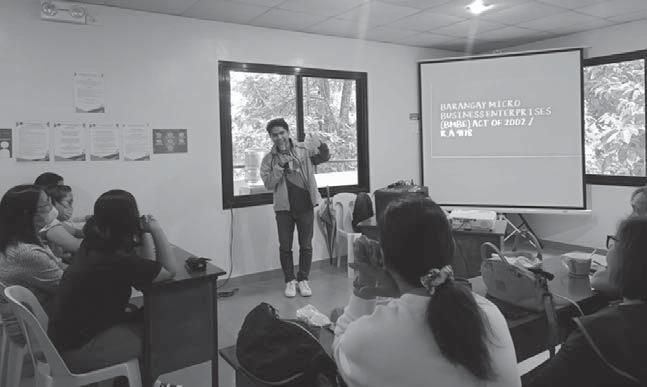
program the microentrepreneurs can participate in to boost their pieces of knowledge and enhance their skills,” the statement read.
“Afterwards, Cainto discussed the process and requirements of legalizing their business and what they can benefit from doing so.”
According to the DTI, in the last part of the seminar, Business Coun-
the dedication of the DTI to empower the community to make everyone happy.”
“Their role of promoting consumer rights is crucial in maintaining a fair and balanced marketplace,” the DTI statement read.
THE Department of Trade and Industry (DTI) announced recently that a graduation ceremony for the second batch of the “Increasing Digital Skills and E-commerce for Asean Women MSMEs” (IDEAS) project pushed through on July 24 the City of Dasmariñas amidst Typhoon Carina.
The DTI said through a statement that the project is a partnership between the DTI-Cavite and Women’s Business Council
Philippines (WBCP). According to the Trade department, the project “successfully assisted 33 ‘Womenpreneurs’ [women entrepreneurs] from Cavite and Laguna by providing them with nine modules of training and workshops that delve into the various aspects of conducting business online, setting up an e-commerce website and implementing effective digital marketing strategies.”
The project also served as plat-
form for the micro-scale, small and medium-sized enterprises (MSMEs) to showcase their products, network with potential partners, and gain further visibility in the market, the DTI said.
In her message, DTI 4-A Regional Director Marissa C. Argente urged the MSMEs “to always seize opportunities by participating in the programs and projects by the DTI and other government agencies.” Argente also thanked the WBCP for “a fruitful
collaboration and for their advocacy in elevating the businesses of women entrepreneurs.”
DTI Cavite OIC-Provincial Director Lilibeth R. Chavez, Ideas Project Manager Dennis B. Paguio, Ideas resource speaker Jane Maghanoy, and Philippine Chamber of Commerce and IndustryCavite Executive Vice-President Jaime E. Tepora also graced the event to show their support to the MSMEs.
(Transcript of “The Big Take Asia” podcast)
COSTS are rising in Japan and small businesses risk being squeezed into oblivion if they don’t figure out how to raise their prices. After decades of deflation, many small Japanese companies are out of practice on exactly how to do it.
Stevenson: And then their employees are coming to them and saying, look, we have to spend more just to put food on the table every month, you know, can you raise our wages?
it keeps going and going. And people got used to not paying more. And so if you think about it, people in their sort of late thirties, forties, and even fifties in Japan had never really had to step into a situation where they had to negotiate and push for the person on the other side of the table to pay more.
prices. And with higher prices… bigger companies have been able to pay their employees more.
Stevenson: For example, this spring, workers at the biggest companies in Japan won their biggest annual wage hike in like 34 years, about 5.1 percent.
Organized in partnership with the DTI-Competitiveness Innovation Group (DTI-CIG) and QBO Innovation, the ARISE Plus Ye! Boost Accelerator program, launched in 2021 and now in its third cohort, is a 14-week program aimed at providing internationalization support to youth-led startups.
“Europe is an often untapped market for us,” QBO Innovation President Rene S. Meily was quoted in the statement as saying. “Through the ARISE Plus Ye! Boost Accelerator Program, we hope that Filipino startups can gain access to this crucial market and establish a foothold for exports.”
The “Demo Day,” attended by a diverse audience of key partners, investors, and stakeholders, marked the culmination of the program for a dozen business startups from various verticals.
“Mylo Speech Buddy,” developer of a speech development app for children with autism and speech delays, clinched first place, securing a pitch prize of $2,500, or around P146,000.
The Philippine startup ecosystem has shown continuous growth despite the challenges posed by the COVID-19 pandemic. In 2021, the country ranked 52nd globally, with thriving industries including fintech (19 percent), e-commerce (7 percent), education and healthcare (5.2 percent), and agriculture (3.1 percent).
“We’re working together with the Department of Science and Technology (DOST), the Department of Information and Communications Technology (DICT), the National Economic and Development Authority (Neda), and other government agencies to ensure that our economic relationships are fundamental to our strategy, competition, innovation, and productivity,” Trade Undersecretary Rafaelita M. Aldaba said. “We cannot remain static—our industries cannot stay stagnant. Therefore, we are committed to supporting the growth and development of startups in the Philippines.”
On “The Big Take Asia,” Host Rebecca Choong Wilkins talks to Bloomberg Senior Editor Reed Stevenson about a class he visited where people are relearning the long-lost skill of negotiation, and what a failure to raise prices at these small businesses—which make up 90 percent of the economy—could mean for Japan’s future.
Rebecca Choong Wilkins: On a sunny day in April in Matsue, a small city on the western coast of Japan, a speaker stands at the front of a classroom, hands on the podium, encouraging the people in the room to stand up for themselves. The roughly twenty or so people in the classroom pay close attention, taking notes diligently from their seats, while some nod their heads, as Ikkou Kanonji, a veteran negotiator, continues on.
It sounds like the kind of negotiating seminar or business class you might expect to find at a high school or college, but the people here today are not students. Many of them are managers and salespeople in their mid 30s and upwards. They work for small and medium sized businesses in Japan. And they’ve come here because they desperately need to learn a skill they haven’t needed to use in ages—how to raise prices.
So why are people who have already been in business for years taking a class on how to raise prices now? Well, after decades of prices pretty much standing still or falling in Japan—things are starting to change. Costs are rising in Japan, and that’s put smaller and medium sized companies in the country in a tricky spot.
Reed Stevenson: So the smaller companies in Japan are getting squeezed because what’s happening for them is that they’re paying more for electricity. They’re paying more for raw materials, parts and components.
Choong Wilkins: To survive, these businesses will need to raise their prices. And whether or not they are successful has huge implications for Japan’s economy overall—because small and medium sized businesses like these are a critical part of the Japanese economy.
Stevenson: They actually make up 90 percent of the companies in Japan and employ the vast majority of people.
Choong Wilkins: And Japan’s central bank is really paying attention to what happens at these companies—because after years of unconventional monetary policy, the Bank of Japan believes the economy may finally be moving away from decades of deflation and towards some healthy price increases. They’ve already raised borrowing costs earlier this year, and this week, they’ll decide on whether they will raise rates again.
Can small and medium-sized businesses in Japan learn to raise their prices, and what could happen to Japan’s economy if they don’t?
To help us understand how Japan got to this place where people literally need to take a class to learn how to raise prices—I asked Reed to take us back to what’s known as Japan’s “lost decades” which started in the 90s after a massive asset bubble burst.
Stevenson: Once that bubble burst, essentially, the Japanese government engineered what you can call an ultrasoft landing, so it took really more than a decade for all of that to be resolved, for bad loans to be written off. And by the end of that decade, or at least a decade plus, Japan found itself in a deflationary environment. And so prices were going down, and the central bank essentially stepped in and cut rates to zero and then to below zero to try and prop up the economy, but for some reason, when you get into a deflationary cycle, it kind of builds on itself. People spend less. And
Choong Wilkins: But with rising raw material prices after the pandemic, a steadily weakening yen, and a mild economic recovery—prices are picking up again in Japan.
Stevenson: If you’re a consumer you’re seeing this happen at the grocery store, so you’re paying anywhere from maybe 15 to 20 percent more for a carton of milk. You’re paying more for vegetables. And consumers are feeling the pinch.
Choong Wilkins: All of this has prompted the Bank of Japan, or the BOJ, to finally switch gears. And move away from this notion of keeping interest rates below zero. In March, for the first time in 17 years, the BOJ raised borrowing costs to zero—well, between zero and zero-point-one percent.
Stevenson: This sort of healthy cycle, where higher wages feed into more spending, into a sort of robust but manageable level of inflation.
Choong Wilkins: The idea is that if people make more money they can afford to spend more and so prices can go up.
Stevenson: So that you really get the economy essentially working like it used to many decades ago.
Choong Wilkins: So I guess the big question is, is the BOJ’s plan of raising borrowing costs actually working?
Stevenson: So far, this policy is working for the larger companies, especially if they export, because obviously, they can command higher prices abroad where there are in fact quite significantly inflationary environments.
Choong Wilkins: Essentially what Reed is saying here is that big brands like Toyota or Uniqlo or 7-Eleven have an advantage because they can sell outside of Japan, in places where prices are just generally higher right now because of inflation. So they can charge more for their products in those places and raise
Choong Wilkins: But for small and medium sized businesses, Reed says it’s a different story.
Stevenson: The small and medium sized companies that really make up the bulk of the Japanese economy, this cycle doesn’t appear to have kicked in just quite yet.
Choong Wilkins: Why is it that smaller businesses like the ones that are going to the class that you attended, why aren’t they seeing the same kinds of benefit?
Stevenson: What you have to understand is that the small and medium sized businesses in Japan are very often at the mercy of their customers, which are very often larger companies. And the larger companies, for decades now, were able to dictate the terms of the business relationship. And it reminds me of an interesting phrase that you hear in Japan, which is ikasazu, korosazu, which roughly translates as don’t let them live, but don’t let them die. And this was actually a term that was used by feudal lords hundreds of years ago about how peasant farmers should be treated. But it actually came up over the modern era, the post-war economic era, as a way to treat suppliers, to treat the smaller companies that serve the larger companies, basically, keep them alive enough to provide parts and goods and services, but never let them die.
Choong Wilkins: And on top of this rigid power dynamic that’s been entrenched for years, there’s a cultural element here at play here too Stevenson: There’s a certain element of being seen as greedy. So rather than laying out a rational argument and using data and evidence to press your case, there’s a fear by these smaller companies that they might be seen as greedy or taking advantage of a situation where really all they’re trying to do is just keep their business afloat.
By Reine Juvierre Alberto
THE national government ramped up its borrowings in July, raising a total of P145 billion from the sale of Treasury bonds (T-bonds).
The Bureau of the Treasury (BTr) capped its July auctions by making a full award of the reissued 20-year long-term debt papers on Tuesday amid lower investors’ asking yields. With a remaining life of three years and one month, the long-term debt papers fetched an average rate of 6.009 percent with a coupon rate of 8.625 percent, according to the Treasury.
THE Coins Deposit Machines (CoDMs) have collected
P831.774 million after a year since its rollout in June 20, 2023, according to the Bangko Sentral ng Pilipinas (BSP).
The average rate is lower than the comparable 3-year PHP BVAL yield at 6.121 percent as of July 24, 2024. Meanwhile, the average yield is lower by 0.34 percent than the 6.347 percent average rate of the 3-year tenor T-bonds in the past previous auction on May 28, 2024. Investors asking yields ranged from a low of 5.970 percent to a high of 6.034 percent, according
to the Treasury.
The auction was 2.1 times oversubscribed with total tenders reaching P62.6 billion.
“With its decision, the committee raised the full program of P30.0 billion, bringing the total outstanding volume for the series to P91.1 billion,” the Treasury said through a statement.
Rizal Commercial Banking Corporation (RCBC) Chief Economist Michael L. Ricafort said the lower average auction yield is due to the market expectations of the 25 basis points rate cut on August 15 and in the fourth quarter of 2024 as signaled by members of the Monetary Board.
“Global crude oil prices decline to new 1.5-month lows and also among 2.5-year lows or since December 2021 that could help ease inflation,” Ricafort said.
The RCBC executive also cited the benchmark 10-year US Treasury yield is recently also among 4.5-month lows, now at 4.18 percent ahead of the US Federal Reserve rate-setting meeting on July 31, 2024.
Finance Secretary Ralph G. Recto said the Monetary Board (MB) is on track to reduce key policy rates this year, but admitted he’s a “little more conservative” of a rate cut in August.
If the MB reduces policy rates next month, a 25-basis points rate cut could happen, reducing policy rates to 2 percent. This would be the first time the Bangko Sentral ng Pilipinas cut rates since November 2020.
The government has borrowed P1.422 trillion from January to May this year, with domestic borrowings reaching P1.170 trillion and foreign borrowings at P251.712 billion.

By Zoilo P. Dejaresco III
INADEQUATE power facilities have often stymied Bohol’s tremendous tourism potential for the past two decades.
For instance, Bohol plunged into total darkness after the 2013 earthquake and the Yolanda super typhoon when submarine cables from its Leyte submarine cable power interconnection power source went kaput. There were no alternative power sources.
The province would sometimes wait for weeks for power to return to normal.
Yet, Bohol tourism in 2023 showed P75 billion in total receipts which was pivotal in bringing Bohol’s GDP (gross domestic product) 2023 growth rate to 7.1 percent, way above the national average. Tourist arrivals in 2023 also broke above the one million barrier, a 313 percent rise from the 2022 numbers.
and Siargao at 36 percent. Currently, Bohol is finishing 1,790 additional rooms. Boracay has dismally fallen to No. 6 at 2 percent due to its engineered shift to focus on local tourists only. It is a “progressive shift” according to astute hotel owners.
Power response
Coins amassed by CoDMs amounted to P831.774 million from June 20, 2023, to July 15, 2024. This is higher by 6.14 percent than the P783.629 million collected as of last month, June 23, 2024. About P2.133 million have been accumulated by the machines after 390 days since its launch. In terms of pieces, the BSP said 223.021 million pieces of coins have been deposited into the 25 CoDMs placed in various malls and groceries in Metro Manila. This is higher by 5.35 percent than the 211.690 million pieces of coins deposited as of June 23, 2024. Each CoDM has received 8.92 million pieces of coins since June 20, 2023, or 24,777 pieces per machine every day.
centavo, 10 centavo, 25 centavo, P1, P5, P10 and P20 coins. All denominations of the BSP Coin Series and New Generation Currency (NGC) Coin Series are accepted by the machine.
Transactions made through the CoDMs reached 202,110 deposits since its launch. Deposits also increased by 5.37 percent from the 191,804 transactions recorded as of June 23, 2024. The CoDMs accept 1 centavo, 5
Tieza rakes in ₧1.4B in taxes as outbound travel surges
By Ma. Stella F. Arnaldo Special
BusinessMirror
TThe BSP launched the CoDMs across the Greater Manila Area to encourage the public to deposit their idle coins in the machines and to promote efficient coin recirculation in the country.
The BSP said it also aims to address the artificial coin shortage in certain areas of the country and help ensure that only fit and legal tender currency is readily available
for public use.
The current 25 CoDMs are also planned to be doubled this year to reach those living outside the Greater Manila Area due to the “overwhelming” success of the program, according to BSP Regional Operations and Advocacy Sector Deputy Governor Bernadette Romulo-Puyat.
The BSP partnered with three mall operators for the deployment of the CoDMs.
The coins deposited could also be converted into e-wallet credit and SM shopping vouchers.
Reine Juvierre Alberto
Global rate decisions loom large for EM carry trades
“Revenge local travel” and the three daily flights from Korea to Bohol pushed tourism demand and Bohol’s power needs to escalate from 90 megawatts (MW) to 130 MW— creating a shortfall in supply.
Also, recently, the National Economic and Development Authority approved the P4.3-billion expansion of the Panglao-Bohol International Airport, which will increase its carrying capacity from 2 to 2.5 then eventually to 4 million passengers.
And the future even looks brighter. According to a survey by Leechiu Property Consultants Inc. of 10,000 hotel room potential investors, Bohol is the No. 1 desired place to set up hotels by investors garnering a 41-percent preference. Even eclipsing Manila (second) at 39 percent
BUT just in the nick of time, the National Grid Corp. recently announced the beginning of the Cebu-Bohol P19-billion 230-kilovolt (kV) interconnection facility. The Dumanjug -Corella-Maribojoc connection by submarine cable will translate to at least an additional 600 MW and at 1,200 full capacities. Further good news. The Cebu-Bohol grid will also ease the congestion of the Leyte-Bohol 138-kV interconnection, which will translate into eventual lower power costs in Bohol. When it rains, it pours. This time, with more power supply from private sources, allaying the fears of an impending power shortage expressed by Energy Undersecretary Rowena Cristina L. Guevara. The Yuchengo-led Petrogreen Energy Corp., for instance, is starting its 27-MW solar power project in San Vicente, Dagohoy. Also actively pursuing energy projects in Bohol is the Energy Development Corp. (EDC), a leading renewable energy group, which will help ensure Bohol has more than adequate power in the next 10 years.
While multi-billion pesos remittances from overseas Filipino workers have been increasing, mainly from seamen, it has been tourism that has always been Bohol’s flagship industry providing livelihood to its growing 1.4 million population.
Zoilo P. Dejaresco III, a former banker, is a financial consultant media practitioner and author. He is a Life and Media member of the Financial Executives Intitute of the Philippines (Finex). His views here, however, are personal and do not necessarily reflect those of Finex and the BusinessMirror. Email dejarescobingo@yahoo.com.
Thailand 176,937; the United States 160,056; South Korea 104,871; and, Qatar 89,219. The data does not make any distinctions between outbound tourists and Filipinos traveling for work overseas. All outbound travelers, regardless of nationality, pay travel taxes, 50 percent of which are retained by Tieza under law, and is used to fund its projects. The rest of the collections are forked over to the Commission on Higher Education (40 percent) and to the National Commission for Culture and Arts (10 percent).
P47.5M for facilities
The TFAFs will also have a secondary purpose by providing preventive care as these will have a second floor that can serve as a lifeguard station or a viewing deck to oversee tourist safety. Public bidding for the project is scheduled for August 2024, he said.
Pact signed LAST Monday, officials of the Tieza, the DOT and the Department of Health (DOH) signed a memorandum of understanding to formalize the partnership to establish Tourist First Aid Facilities (TFAF). The first batch of TFAFs will be located in destinations with a high concentration of tourists such as La Union, Boracay Island, Siargao, Panglao Island, Palawan and Puerto Galera, according to a statement from the DOT.
Tourism Secretary Christina Garcia Frasco said that La Union will be first to break ground in August, with all TFAFs scheduled to be completed by March next year. The DOH will staff the TFAFs with well-trained physicians and nurses, “and will be equipped with essential medical supplies and medications to ensure prompt and effective emergency assistance,” Frasco said. “The establishment of the tourism emergency facilities in our key tourist destinations reflects our government’s dedication to providing access to health services,” Health Secretary Teodoro J. Herbosa was quoted in the statement as saying. “These facilities will not only enhance the safety of our tourists but also contribute significantly to the health tourism objective.” Solar-powered first aid booths will also be established along the coast and beachfronts to address the immediate medical needs of tourists, even if there are no medical personnel around, said the DOT. These booths will be equipped with first aid supplies, automated external defibrillators, a pullout stretcher, a CCTV camera and a two-way communication system linking to a command center.
THIS developed as Tieza is allocating P47.5 million to fund five first-aid stations and five tourist first-aid booths in key tourism destinations of the country, according to Tieza Chief Operating Officer Mark T. Lapid. Lapid added that the allocation is good for a year. The government firm will be spearheading the design and construction of the facilities, “which will function as emergency response centers for tourists encountering accidents or injuries” in those destinations, Lapid told the BusinessMirror. “It will be the first contact of tourists to healthcare effort it gets to a higher level facility, much like where you can bring a medically distressed tourist before responders arrive.”
EMERGING-market currencies gained as investors brace for a week of global interest-rate decisions that will impact carry trades across the developing world.
MSCI’s index for developingworld currencies eked out only its second gain in nine sessions as of 10 a.m. in London, rising less than 0.1 percent. The emerging-market stocks gauge fell 0.3 percent, led by a drop in tech shares including Tencent Holdings Ltd. and Taiwan Semiconductor Manufacturing Co. Ltd.
Barclays strategists noted that market moves in recent weeks have been more unpredictable than usual due to political surprises around the globe, with volatility hammering the carry trade, in which traders typically borrow at lower interest rates in developed markets to then seek higher returns by investing in developingworld assets. After a brief respite, renewed pressure has emerged as slowdown concerns spread due to disappointing US earnings, they said.
“While it’s true that volatility could fall into August after the slew of central bank meetings,” the “case for carry is weaker,” strategists including Themistoklis Fiotakis wrote in a report. “With noise expected down the road, we think investors are unlikely to pile into carry beyond tactical expressions when moves look extended.”
Volatility spikes
AS investors try to navigate a gradually slowing US economy and the uncertainties of the upcoming US presidential elections, the market is likely to remain turbulent, the Barclays analysts said. The potential for volatility spikes means that carry gains can quickly be erased, making
it difficult for investors to maintain positions. And with emerging currencies already priced to erode and limited cushion from US rate spreads, the case for carry is weak, they said.
Carry trades funded in yen and dollars have suffered the most as traders weigh the monetary-policy outlooks for each of those economies.
All yen-funded trades in emerging markets have made losses, with Chile’s peso and the Taiwanese dollar most affected. Both the Bank of Japan and the Federal Reserve will decide on interest rates on Wednesday.
There’s uncertainty in markets about what the Bank of Japan will do after years in which it rarely touched rates. The assumption that further policy tightening is possible sent the yen racing to an almost three-month high last week.
Investors will then scour the Fed’s policy announcement and Chair Jerome Powell’s remarks later on Wednesday for anything that supports expectations of a first interestrate reduction in September.
In Latin America, Venezuela’s opposition said it can prove that Edmundo González won Sunday’s election, according to María Corina Machado, who led the campaign against President Nicolás Maduro. India took steps to shield more of its bonds from foreign ownership, in a sign it’s uncomfortable with the billions of dollars of inflows linked to the inclusion of its debt in a key global index.
Ethiopia’s eurobond jumped the most since December after the country secured a deal for a $3.4 billion program with the International Monetary Fund. The security maturing in 2024 jumped to its highest since November 2021. Bloomberg News
In opening financial accounts, Filipinos opt for speed-report
FILIPINO consumers have a low tolerance for inefficient digital experiences when opening a financial account via mobile app or website, a report by the Fair Isaac Corp. (Fico) revealed.
The study of 12,000 consumers in 13 countries revealed that majority of Filipinos opening a new financial account place a high value on both good fraud protection and ease of use.
According to Fico’s report, three in five (59 percent) expect to answer 10 questions or less or they will abandon the application process in opening a personal bank account. Just over one in four (26 percent) will drop out if asked more than five questions.
Regardless of the number of questions asked, one in five Filipinos will give up on a personal bank account application after 10 minutes, the report revealed.
In the past year, Fico noted that more than half of Filipinos have noticed more identity checks when they log in to bank accounts (58 percent) or make an online purchase (61 percent).
The increase in identity checks by Filipino banks is a direct response to the significant issue of identity theft in the country, a statement by Fico reads. Just 5 percent have confirmed that their identity has been fraudulently used to open an account, but one in four (26 percent) suspects that it has.
Despite this, frustration with identity checks can alter consumer behavior. The Fico survey revealed that one in four bank customers have either stopped or reduced their use of existing personal bank accounts and
credit cards, citing the cumbersome and time-consuming nature of these identity verification processes.
According to the survey, Filipino consumers showed varying levels of patience for different account opening processes. They are most likely to abandon personal bank account applications (32 percent) due to complex or time-consuming identity checks. Close to one in three (30 percent) have abandoned savings account applications for the same reason, while roughly one in five (21 percent) have been frustrated enough to abandon mortgage applications.
Additionally, only 6 percent of Filipino consumers feel comfortable opening a mortgage account through digital channels, while more than half (52 percent) prefer to apply for personal loans in person at a branch, rather than opting for online alternatives.
While some consumers are more tolerant of detailed processes for certain financial products that require thorough scrutiny, the survey clearly shows that expectations for ease of use remain high.
“As banks encourage more customers to use digital services by promising faster online loan approvals, reducing consumer frustration caused by lengthy identity checks must be an imperative,” added Sharma. “Nearly half of Filipinos (49 percent) will not complete a digital mortgage application if it has more than ten questions, and more than half (59 percent) of personal loan applicants will abandon the process after ten questions.” Rizal Raoul Reyes


with
and a
“We are
with
to host the Second Protech 2024
Badminton Tournament, now sanctioned by PBAD. The presence of Chan Peng Soon as our special guest will undoubtedly elevate the competition and inspire all participants,” said Ric Dizon, Protech Philippine President.
Organizers of the event are expecting a huge number of badminton enthusiasts to join the Second Protech 2024 Open Badminton Tournament.

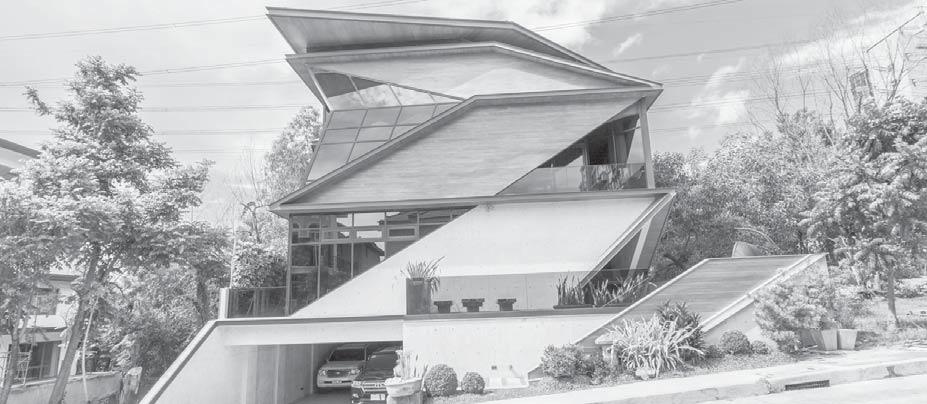

Leading firm in contemporary Philippine architecture bags 2 awards for residential and commercial projects

THE lingering effects of the southwest monsoon and recent typhoons Butchoy and Carina (international name: Gaemi) are still being felt in many parts of the country. The floods, landslides, and damaged homes have affected 880,000 individuals or 180,000 families nationwide.
A report from the Philippine Red Cross (PRC) Operations Center says more than 11,800 families continue to stay in over 200 evacuation centers in Metro Manila and other regions as of July 29, 2024. Over 5,000 families also remain in evacuation centers in Mindanao, which was hit by heavy rains, floods, and landslides days before Carina passed through Luzon and the Visayas. Red Cross 143 volunteers and staff have been mobilized to respond to Filipinos’ calls for help, living up to the Red Cross mantra of being “always first, always ready, and always there.”
“During these challenging times, the public can always count on the Red Cross to help vulnerable communities in need. Our dedicated volunteers and staff are continuing to aid families affected by typhoons Butchoy and Carina, and are helping them rebuild their lives,” said Red Cross Chairman and CEO Dick Gordon.
PRC Secretary General Dr. Gwen Pang added, “We are calling on the public to support the efforts of the Red Cross as we strive to help communities recover from this disaster.”
Red Cross emergency response units (ERU) and water, search, and rescue
(WASAR) teams have assisted 500 and rescued 400 individuals who were either stranded on the streets or trapped in their homes due to knee-to chest-deep floods in affected areas.
Hot meals like arrozcaldo and champorado were given to 24,000 displaced people in Luzon and Visayas, as well as nearly 5,000 individuals in Mindanao. Disaster Management Services (DMS) teams have also distributed hygiene kits and food packs to affected communities in the provinces.
Around 30 first-aid stations were set up, and ambulances mobilized by Red Cross Health units to conduct health consultations and check-ups for ailing individuals, especially in evacuation centers. Medicines, particularly the anti leptospirosis Doxycycline, were also administered to residents in Mandaluyong, Marikina, Makati, Bataan, and La Union.
To ensure the protection of children during their stay in the evacuation center, Red Cross Welfare units have set up 700 child-friendly spaces, as well as given psychosocial first aid to 2,000 people.
Water, Sanitation, and Health (WASH) teams have sent water tankers with a total
METRO Pacific Investments Foundation (MPIF) continues to make significant progress in environmental protection through its flagship program, Shore It Up! In a renewed commitment to preserving marine ecosystems, MPIF has signed Memorandums of Agreement (MOA) with the local government units of Del Carmen and General Luna in Siargao, providing P4 million to support these efforts. These projects are part of the MVP Group’s ongoing aid for the postOdette programs. After completing the response, recovery, and rehabilitation phases, MPIF is now implementing the mitigation phase through these initiatives.
MPIF has strengthened its long-standing partnership with Del Carmen through the Mangrove Protection and Information Center Program. This collaboration aims to enhance the capabilities of Mangrove Eco-Guides with tailored enhancement training, uniforms, office equipment, and materials. Additionally, MPIF will provide a monthly allowance for four Mangrove Eco-Guides over three years.
Del Carmen Mayor Alfredo Matugas Coro II shared his appreciation for the continued partnership, stating, “It has been more than a decade since we have started our partnership with MPIF and the MVP Group when the Municipality of Del Carmen was an unknown local government and community to becoming a benchmark for environmental governance in the Philippines and recently, the world. Today, we are here again to show the continuity of the partnership and trust that allowed Del Carmen’s campaign and advocacy on the environment to transform our people and our governance to look into nature-based solutions for development.”
The partnership will also see the establishment of the Mangrove Protection and Information Center 2,
continuing the efforts that have helped mitigate damages from typhoon Odette and promote environmental awareness and tourism.
In General Luna, MPIF is launching the Marine Protection, Inspection, and Conservation Guardians program. This initiative aims to empower the local Bantay Kalikasan (BK) volunteers with training, enhancing their knowledge and competence in patrolling 5 Marine Protected Areas (MPAs). They will also be provided with necessary tools of the trade such as GoPros, two-way radios, GPS systems, and searchlights. These resources will empower the guardians to effectively monitor and protect their designated areas.
Mayor Sol Matugas of General Luna, recognizing the foresight needed to safeguard marine life and promote sustainable fishing practices, emphasized the importance of partnering with MPIF. “We hope this partnership will bear fruit that will be meaningful to future generations.
This is our way of giving back to the community, and acknowledging the blessings we have received from God.”
MPIF President Melody del Rosario commented on the significance of these initiatives, saying, “Through these collaborative efforts, we are not only protecting our marine environments but also developing livelihoods, promoting environmental sustainability, and enhancing climate change resilience. At MPIF, we remain dedicated to supporting Siargao and its local communities, ensuring a positive impact on both the environment and the lives of the people.”
MPIF’s mangrove protection and marine guardians projects are aligned with the United Nations Sustainable Development Goals (SDGs), particularly Goal 8: Decent Work and Economic Growth, Goal 13: Climate Action, and Goal 14: Life Below Water. These initiatives reflect the Foundation’s holistic approach to environmental sustainability and community development.

food culture of Hong Kong with the traditional Hong Kong Curry Fish Ball, featuring fish balls simmered in a fragrant curry sauce. “Red Spice is a celebration of authentic Chinese cuisine, brought to life by the incredible talent of Chef Dicky Suen,” said Andreas Balla, Vice President for Food and Beverage at Okada Manila. “His dedication to his craft and his ability to create dishes that resonate with our guests are truly remarkable. At Red Spice, every meal is a masterpiece that

reflects his passion and expertise.”
With over 40 dining options that span a wide array of global cuisines, Okada Manila continues to set the standard for culinary excellence in the heart of Entertainment City. The ongoing food and beverage campaign, “Beyond Flavors, A Feast for the Soul,” emphasizes the emotional and transformative power of food. It highlights how dining at Okada Manila offers more than just culinary delights—it promises an experience that satisfies deeper emotional and spiritual needs, akin to a feast for the soul. Each restaurant at Okada Manila, from the Italian-authentic La Piazza to the intimate Ginza Nagaoka, is designed to offer a unique and enriching culinary adventure. Guests can expect to be transported into a world where refined ambiance meets exceptional service, and each meal is crafted with passion and the finest ingredients. “Beyond Flavors, A Feast for the Soul” encapsulates the essence of Okada Manila’s dining experience. Whether celebrating a special occasion or simply indulging in the everyday joy of a well-prepared meal, guests will find that every dish tells a story, and every meal is a celebration of life’s finest pleasures. For more information about Okada Manila’s dining options and to make reservations, please visit https://www. okadamanila.com/beyond-flavors-a-feast-for-the-soul

load of 27,375L, to deliver clean water to thousands of families in Marikina, Cavite, and Valenzuela.
As the floods subsided, ERUs supported clearing and flushing operations in communities, schools, and other buildings. A Red Cross payloader was deployed to Marikina City to assist in clearing the city’s roads and pathways of mud and debris.
The Red Cross is monitoring the
situation on the ground as flooding persists in Malabon, Valenzuela, Pangasinan, Pampanga, Tarlac, and Bulacan. Assessment is also being done to ensure people’s safety when they return to rebuild their homes and move forward with their lives and livelihoods.
The Red Cross is urging the public to donate to its emergency relief drive to maintain its disaster operations for the typhoon victims.


Aphrozone Philippines Nurtures Natural Ageless Beauty Through Its ‘365 Ruby-Cell’
TODAY’S advances in medical technology have seen the increased usage of stem cells for general cell repair and regeneration. And this procedure also extends to dermatological applications. However, Aphrozone Philippines takes a more natural approach to skin care by harnessing plant stem cells.
Aphrozone Philippines is the sole and exclusive distributor in the Philippines of “365 Ruby-Cell,” the plant-based stem cell dermatology product range made by Aphrozone Co. Ltd. Korea, a global company leading in stem cell dermatology.
Aphrozone Philippines’ “365 RubyCell” is rooted on three phyto stem cells, which have an abundant source of growth nutrients. These are sea fennel extract, edelweiss, and ginseng. These natural sources work together to address skin issues that may arise from various factors like age, medical conditions, nutrition, fitness level, and the environment. This organic approach is the backbone of Aphrozone Philippines’ “365 Ruby-Cell” range of skin-care products and devices. Here are the steps for skin care using Aphrozone Philippines’ “365 Ruby-Cell” range: Step 1 (Skin Cleanliness) uses “365 RubyCell” Intensive 4U Silky Cleanser, a cream cleanser that removes excess sebum and dead skin cells Step 2 (Skin Nutrition) involves “365 Ruby-Cell” Intensive 4U Mist which offers immediate moisture, along with “365 RubyCell” Intensive 4U Ampoule for vitality and radiance of the skin

Step 3 (Skin Protection) utilizes the “365 Ruby-Cell” Airbrush System, a convenient and easy to use mist spray that works to maximize the
By Rizal Raoul S. Reyes @brownindio
THE Philippines should address the issues on ease of doing business, infrastructure, education and internet connectivity. With limited space, let’s tackle infrastructure and internet connectivity.
According to Colliers Philippines offices services division director Kevin Jara, infrastructure and traffic congestion remain a perennial challenge for the Philippines. In a report by The TomTom Traffic Index, it takes about 25 minutes and 30 seconds to travel 10 kilometers in Metro Manila, the slowest compared to 387 metropolitan areas in 55 countries. With the workforce and businesses concentrated in major central business districts, transportation issues significantly hinder economic efficiency of the Philippines, with economic losses due to traffic congestion amounting to P3.5 billion a day in Metro Manila alone.
Moreover, Jara said the Ninoy Aquino International Airport (NAIA) has also been ranked as the “world’s worst” airport due to long and excruciating queuing times and frequent flight delays. In 2023 alone, NAIA faced multiple controversies, including power outages and a system glitch that paralyzed the country’s airspace for 10 hours. The government tapped diversified conglomerate San Miguel Corp. to rehabilitate the airport through a public–private partnership (PPP) deal. Both previous and current administrations have poured significant investments through the “Build, Build, Build” program (now known as “Build Better More”) to address these enduring infrastructure problems. The budget for the Department of Transportation (DOTr) doubled from P106 billion in 2023 to P214 billion in 2024, with 76 percent




of the DOTr’s budget allocated to fund big-ticket railway projects, such as the Metro Manila Subway, the LRT-7 Cavite Extension, and the North–South Commuter Railway.
“The PPP code is also expected to accelerate the approval and implementation of infrastructure projects, aiming to secure project approvals within 120 calendar days, faster than the previous 180-day period. Currently, 125 projects valued at over P3 trillion are in the PPP Center’s pipeline, including projects for the construction of expressways and airports. However, railway projects like the Metro Rail Transit Line 7 (MRT-7) are facing further delays due to right-of-way issues
PASAY CITY, Philippines, July 26, 2024
—MyTown Co-Living, anetwork of 14 residential facilities strategically located near Taguig’s Bonifacio Global City (BGC) and the Makati Central Business District, is redefining urban living for young professionals in the area.
Founded in 2012 by Philippines Urban Living Solutions Inc. (PULS), MyTown was envisioned by Dutch-Filipino entrepreneur Mark Kooijman. His concept emerged from understanding the housing challenges faced by employees in a BPO office he previously owned in BGC, with approximately 80 percent expressing a desire for affordable housing closer to their workplace.
“Mark Kooijman identified a significant gap in affordable, professionally managed housing options for young professionals,” said Jogee Arellano, CEO of MyTown, who joined the company in 2014. “He recognized that while many were willing to work in BGC, they struggled to find affordable living options within or near the business district.”
An affordable walk-to-work lifestyle
MYTOWN’S core mission remains to provide accessible housing solutions for young professionals in BGC and Makati. Initially catering primarily to BPO workers, MyTown now serves a diverse clientele from various sectors across Metro Manila.
With 14 buildings housing a total of 4,156 beds and 1,353 rooms, MyTown offers a range of accommodation options. Rates start at P4,260 per person per month in a deluxe 6-bed shared room and P4,610 per person in a first-class
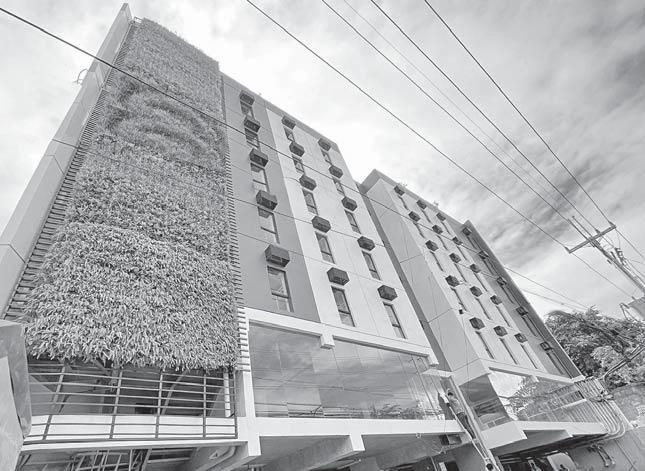
Makati,” said Arellano.
Maximizing time and reducing stress BEYONDaffordability, MyTown’s true value lies in its ability to help young professionals manage their time effectively and reduce stress. By offering a walk-to-work option, MyTown minimizes commute times and associated stress, allowing residents to focus on their professional and personal lives.
“If you commute from distant areas like Fairview, Novaliches, or in Cavite or Laguna, the costs and stress of daily travel are significant,” Arellano said. “MyTown offers a solution that not only saves time and money but also enhances the overall well-being of young professionals.”
For more information on MyTown Co-Living and its services, visit www.mytown.ph.
About MyTown Co-Living: MyTown Co-Living provides affordable and professionally managed urban living spaces tailored to young professionals working near Bonifacio Global City and the Makati Central Business District. With a focus on convenience, comfort, and community, MyTown offers an innovative solution to the urban housing challenge.

in its Bulacan segment,” Jara says in his blog “Getting back on track: Overcoming red tape, infrastructure, and education woes to boost PH competitiveness.”
A collaborative effort from the government, private sector, and academia is needed to establish a favorable environment to attract foreign investors, boost economic development, and build inclusivity.
Unlike developed economies that have been consistently ranked high in competitiveness due to their efficient markets, sound fiscal policies, mature infrastructure, and stable macroeconomic environments, a Third World country like the Philippines has to hurdle a lot of challenges.
In its latest release of International Institute for Management Development’s (IMD) 2024 World Competitiveness report cited that the Philippines ranked 52nd out of 67 participating countries, maintaining its ranking from the previous year but dropping four places from 48th in 2022.
At the end of the day, Colliers believes that the troika of government, private sector and the academe will be essential in creating a conducive environment for economic growth, attracting foreign investments, and ensuring longterm prosperity for the country.
Converge responds connectivity issues
LEADING fiber broadband and technology provider Converge ICT Solutions Inc. has responded to the call of the government to provide better connectivity to millions of Filipinos. It partnered with Texas-based Ribbon Communications Inc. to introduce in the Philippines the latter’s leading-edge Apollo optical networking system which will optimize data transmission across the internet provider’s backbone network.
Converge CEO and Cofounder Dennis Anthony Uy says the company is breaking ground on
Ribbon’s 5 nanometer (nm)— 140Gbaud transmission chipset that will expand its fiber network capacity from its existing 800 Gigabits per second (Gbps) to 1.2 Terabit per second (Tbps) per channel within the network, which can increase threefold the needed capacity for hyperscale applications that typically require around 400 Gbps.
“Ribbon’s solution surpasses our stringent requirements for this overlay on our existing backbone, enabling us to set a new standard for innovation. This new technology will bring our customers unprecedented speed and high bandwidth availability amid the growing demand for data-intensive applications,” explained Uy.
Uy said Ribbon’s 5-nm chipset delivers superior performance, is more energy efficient, and has better heat management capabilities. Further, it is one of the most sustainable technologies for optical networks today.
Ribbon COO and EVP Sam Bucci expressed excitement with the business partnership with Converge. He adds Ribbon’s technology, local presence and proven round-the-clock after-sales support are key factors to support Converge ICT’s expansion programs.
DAVAO City, the crown jewel of Mindanao, remains to be one of the Philippines’ most promising investment hot spots. Known for its economic dynamism and high quality of life, Davao offers a fertile ground for investors looking to capitalize on a region poised for exponential growth.
Davao’s business landscape is as diverse as it is vibrant. The city has seen robust economic growth over the past decades, and as it is the economic powerhouse of Mindanao, Davao serves as a gateway to the vast markets of the ASEAN region. Its well-developed infrastructure, including the Davao International Airport and a network of seaports, ensures seamless connectivity.
The region is primarily known for its agricultural produce including high-value crops such as bananas, pineapples, and cacao, but Davao has actually more to offer. Over the years, it has become a favorite of many travelers given its natural beauty and numerous attractions like Mount Apo and Samal Island’s pristine beaches.
Secure environment
“WE know Davao to be one of those areas in the country where the quality of life is really different. Davao City is often praised for offering a safe and secure environment for its residents. The local government’s stringent law enforcement and community-driven safety initiatives have created a conducive environment for many individuals to raise a family,” said Sta. Lucia Land president Exequiel Robles.
“And this is something that we, as developers, value because it enables us to achieve our goal of creating communities that does not only appreciate in value over time but also allows for an improved and enhanced quality of life,” he added.
As Mindanao’s growth hub, it has seen numerous infrastructure developments over the years, including roads, bridges and utilities that helped further propel economic activity in the city and the rest of the region. Among the recent infrastructure developments expected in the area is the 45.5 km, four-lane Davao City Bypass which upon completion could benefit 15,781 daily travelers.
Also, the city has been gearing up to regain its position as a major tourist destination, particularly for the meetings, incentive, conventions and exhibitions (MICE) market.
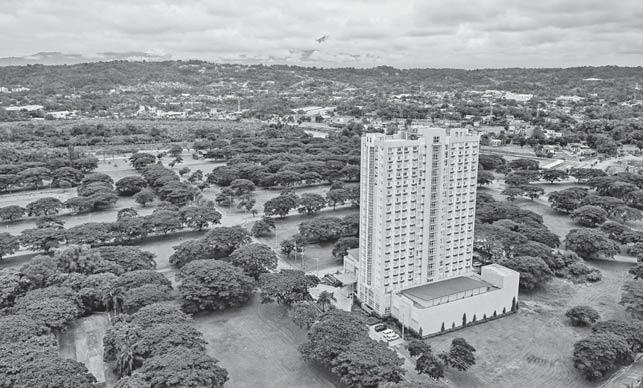
It has likewise set the stage for property developers to create large scale mixed use developments, condominium towers and high-rise offices.
Seeing opportunities
“WE’VE been seeing such opportunities in Davao for more than a decade and this is the reason why we have long established our presence in the city. Our numerous developments across the City of Davao serves as testament to our continuing mission of creating and deliving high quality developments outside of Luzon. We see Davao to be a very good destination for the company and we remain steadfast in further strengthening our foothold in the area,” Robles shared.
As one of the country’s leading property developers, Sta. Lucia Land offers various real estate opportunities that cater to different needs and preferences including house and lots, condominium units, lakeside and golf communities, hotels and condotels. Its projects are strategically located to provide easy access to commercial centers, educational institutions, and recreational facilities. This ensures that residents can enjoy a convenient and well-connected lifestyle. The company currently has a number of completed and ongoing projects that homebuyers and investors can choose from including Sotogrande Davao, Davao Riverfront (Talomo, Davao), Rancho Palos Verdes, South Pacific, Las Colinas
PARIS—The chants of “Ra-fa! Ra-fa!” roared the moment Rafael Nadal entered Roland Garros for Monday’s match against Novak Djokovic. So hyped was the crowd just minutes in, the chair umpire asked the spectators to be quiet during play.
There’s a very notable difference bet ween the Paris Games and the two Olympics immediately before it: the noise.
From the judo mat to the swimming pool, the star-studded stands at gymnastics and every venue in between and beyond—even 10,000 miles away in Tahiti where surfing is going on—the fans have returned to the Games in raucous fashion. The Paris Olympics are the first with spectators since the Covid-19 pandemic forced Tokyo in 2021 and Beijing in 2022 to host their Games with eerily empty venues.
“This is probably a once-in-alifetime trip for us,” said Jodie Linsey, who flew 23 hours from Australia with an overnight stop in South Korea so her 14-year-old daughter, Ellie, a swimmer, could see her idols in the pool.
It was a trip they couldn’t have made the last two Olympics, which operated under tight pandemic restrictions. The sounds were quite different in Tokyo: Athletes complaining about the scorching heat could be plainly heard. Opponents could eavesdrop as the masked coaches of rivals gave instructions. The squeaking of sneakers on the court provided a soundtrack at basketball. Same with the thud of a volleyball at that indoor venue, and even a splash in the pool.
“I’m someone that thrives off crowd and the environment, so when that wasn’t there in Tokyo, I really struggled to get up for it, and then obviously when it started to go wrong for me in the final, it was really hard to then keep going and push myself and I was really disappointed with it,” said Kimberley Woods of Britain following her bronze medal in the women’s kayak singles slalom event at Paris.
“Here, didn’t have any of that issue. The crowd really spurred you on. It was just there. The noise was there, the atmosphere was there and, yeah, they really spurred you on at the end.”
Hundreds of fans were lined up to enter Roland Garros nearly three hours before Monday’s 60th meeting between Djokovic and Nadal, more than any other two men have played against each other in the sport’s Open era, which began in 1968. Nadal has not revealed if the Olympic stage in Paris, where he won 14 French Open titles, is his farewell tour. AP

THE Philippine Olympians Association (POA) recognized athletes for representing the country in the Olympic Games by awarding OLY Recognition plaques in an intimate ceremony at the Sports and Dormitory Complex of the De La SalleCollege of Saint Benilde recently. Founded in June 2002, the POA is an independent body that acts on behalf of Filipino participants who have competed in the major international multi-sport event.






By Jun Lomibao
PARIS—How focused is Carlos Yulo for these Paris Olympic Games?
“Very,” Cynthia CarrionNorton, who’s been subbing as Yulo’s “mom” on top of being the president of the Gymnastics Association of the Philippines even before the 24-year-old from Leveriza in Pasay City became world champion in vault and floor exercise and a first-time Olympian in Tokyo 2020, said on Monday.
“’Know what? Caloy’s so focused that yesterday [Monday] he forgot his accreditation card at the training gym and he was barred from entering the Athletes Village,” Carrion-Norton told BusinessMirror. “So we had to get him a new one.”
Having said that, Carrion-Norton said Yulo has the vault and floor exercise final set later in the week in his mind.
The men’s all-around on Wednesday?
“He will not win that,” CarrionNorton said, bluntly. “He’s not that good in the rings, [pommel] horse and high bar.”
“But the vault and floor, he will… gold,” she stressed.
Yulo vies in the first of his three final events—men’s all-around of artistic gymnastics that his team and almost everybody else at the Bercy Arena expect to be dominated by China’s Zhang Boheng and Japan’s Shinnosuki Oka and Daiki Hashimoto, who were 1-2-3 in the qualification round last Saturday. Yulo wound up ninth—one of only six Asians—among the 24 qualifiers for the all-around final where Fil-Brit Jake Jarman, who was fifth last Saturday, is
The POA is affiliated with the World Olympians Association and accredited by the International Olympic Committee.
The distinction was handed by Philippine Sports Commission commissioner Walter Torres and POA president Akiko Thomson-Guevara and treasurer and Benilde Center for Sports Development director Stephen Fernandez. The honorees were judoka Benjamin Mcmurray and fencer Percival Ager for their remarkable participation in 1988 in Seoul.
The accord was also bestowed to swimmers Christine Jacob Sandejas (1984 Los Angeles), Rene Concepcion (1988 Seoul) and Jessie Lacuna (2010
BEYOND the glow in victory is also the luster behind a defeat. Take the case of Samantha Catantan. Catantan, nicknamed Sam, lost her second-round match but not after putting up a valiant fight that earned her plaudits from everywhere.
She made the most out of her Olympic debut, becoming the first female Filipino fencer to make it to the Summer Games in 100 years. Catantan introduced herself on sports’ grandest










BOOSTING Carlos Yulo’s campaign is Chloe San Jose, who’s by the gymnastics star’s side all the way.
https://www.facebook.com/MelanyTangliben
a darkhorse.
Hashimoto has a shot at becoming the third back-to-back Japanese allaround champion after Sawao Kato (1968 and 1972) and Kohei Uchimura (2012 and 2016).
Also in the mix in the final are Great Britain’s Joe Fraser, Ukraine’s Oleg Verniaiev and Illia Kovtun, Italians Yumin Abbadini and Mario Macchiati, Americans Frederick Richard and Paul Juda, Swiss Matteo Giubellini and Florian Langenegger, Hungarian Krisztofer Meszaros, Australia’s Jesse Moore, the Netherland’s Casimir Schmidt and Frank Rijken, Kazakh Milad Karimi, Brazil’s Diogo Soares, Canada’s Felix Dolci and Rene
Singapore Summer Youth Olympics, 2012 London and 2016 Rio de Janeiro).
Taekwondo jin Kirstie Elaine Alora, hailed for her exemplary performance in 2016 in Rio de Janeiro, was accompanied by Benilde taekwondo coach and Alora’s mentor Roberto Cruz, who previously received the OLY Recognition for his participation in the 2000 Sydney games.
The grantees solemnly took the Filipino Olympian’s oath and pledged to promote the ideals and develop the values of vision, focus, commitment and discipline of the Olympic Movement in the Philippines.

Cournoyer, and Germany’s Nils Dunkel.
Joanie Delgaco, meanwhile, will settle for the qualification phase of rowing’s women’s single sculls after winding up sixth in Tuesday’s Quarterfinal 3 in seven minutes and 58.30 seconds-a clocking that was off her qualification and repechage times of 7:56.26 and 7:55.00, respectively.
Rowing federation president Patrick Gregorio, nevertheless, gave the former beach volleyball player from Iriga City—who already made history as the first Filipina to qualify for Olympic rowing—a congratulatory tap on the back minutes after the race.
“Great effort Joanie, we are very proud of you,” said Gregorio, adding
Alora, who is currently coaching the Taekwondo junior national team of the Philippines and Benilde Taekwondo varsity members, highlighted she is grateful to impart her experience and knowledge to emerging players.
“I want to give back to the community as an athlete,” the Benilde Export Management alumna said. “I think this is also a way of sharing all my learnings and passing it to the next generation.”
Fernandez, taekwondo bronze medalist in Barcelona, commended Alora for motivating the budding prodigies in their respective fields.

PARIS—Hidilyn Diaz Naranjo, the country’s first Olympic gold medalist, is coming to Paris to exercise her functions as a member of the International Weightlifting Federation Athletes Commission.
The women’s 59 kgs weightlifting champion is due here this weekend, according to Philippine Sports Commission chairman Dicky Bachmann.
“She’s arriving either on August 3 or August 4,” said Bachmann, adding that Diaz’s arrival would be a great source of inspiration for other Filipino athletes still in contention among them the three weightlifters—Vanessa Sarno, John Febuar Ceniza and Elreen Ando.
They will check in at the Olympic Village also this weekend. Bachmann said Diaz inaugurated a weightlifting academy on July 26, three years to the very day she clinched the country’s first Olympic gold in Tokyo.
“Her presence will definitely add much-needed inspiration to all our athletes competing in these Games especially that we have a very good start in this Olympics,” Bachmann said.
“She is the face of Philippine sports.” Jun Lomibao
Delgaco was so close to advancing to the semifinals after Serbia’s Jovana Arsic showed signs of cramping but still finished ahead of the Filipina in 7:56:18.
“Only two seconds,” Gregorio said.
“Really close.”
Five-time Olympian Emma Twig of New Zealand, gold medalist at Tokyo 2020, topped the heat with an amazingly fast time of 7:26.89 with Delgaco figuring in the classification or final ranking phase on Wednesday and Friday.
After Tokyo medalists Nesthy Petecio and Eumir Felix Marcial took the ring on Tuesday night, Carlo Paalam opens his golden campaign as well as Hergie Bacyadan on Wednesday at the North Paris Arena.
Bacyadan, the pride of Tabuk in Kalinga, has her fists full as she takes on top-seeded Li Qian of China in the round-of-16 of women’s 75-kg class. Paalam, on the other hand, collides with a young but aggressive Jude Gallagher of Ireland also in the roundof-16 of men’s 57 kgs class.
Japan, meanwhile, hogged the spotlight by provisionally topping the medal table with six gold, two silver and four bronze medals, followed by host France with a 5-8-3 gold-silver-bronze haul, China 5-5-2, Australia 5-4-0 and South Korea 5-3-1.
The United States 3-8-9, Great Britain 2-5-3, Italy 2-3-3, Canada 2-2-2 and Hong Kong-China 2-0-1 rounded out the top 10 in the medals race of these Olympics which features the return of raucous and wildlycheering fans who’re back in the games after being shuttered from Tokyo three years ago
PARIS—Kayla Sanchez advanced to the 16-swimmer semifinals of the women’s 100-meter freestyle by finishing fourth in her heat on Tuesday in the Olympics. The Filipina swimmer clocked 53.67 seconds in Heat 4, registering the 10th best time time overall at Paris La Defense Arena.
Meanwhile, Rower Joanie Delgaco and judoka Kiyomi Watanabe were eliminated, bringing the total number of Filipino athletes already out of contention to six and leaving 16 more to continue the fight. Delgaco, the first Filipina rower to compete in the Olympics, finished last in her quarterfinals heat of the women’s single sculls with a time of 7:58.30.
“Great effort, Joanie. We are very proud of you,” said rowing president Patrick Gregorio, adding that Delgaco narrowly missed qualifying for the semifinals, with a two-second lead separating her from fourth place. Reigning Olympic champion Emma Twigg of New Zealand dominated the heat, while Switzerland’s Katharina Janzen and Spain’s Virginia Diaz Rivas also secured their spots in the next round. Meanwhile, Watanabe suffered a heartbreaking defeat in the round of 32 of the women’s -63kg division. The 27-year-old Filipina was overpowered by China’s Tang Jing, who secured an ippon victory in less than a minute—this was Watanabe’s second consecutive early Olympic exit after a similar fate in Tokyo 2020. With the elimination of Delgaco and Watanabe, the Philippine delegation’s hopes now rest on the remaining 16 athletes to bring honor to the country. Also eliminated from contention two days earlier were Fil-Am gymnasts Emma Malabuyo, Levi Ruivivar and Aleah Finnegan, together with fencer Samantha Catantan. Jun Lomibao


more—a win was within sight, actually, in her second assignment—had an old knee injury not cropped up in the most crucial stages of Round 2. Arianna Errigo, ranked world No. 2, was clearly being cornered until “something popped up” in Catantan’s knee, allowing the 36-year-old Italian so wealthy in Olympic experience to pilfer a 15-12 escape amid adversity. Catantan, ranked lowest in the field at No. 266 in the world, sharply showed her potentials, though, rallying from 6-11 to inch to within 12-14 with still plenty of time left at the 1:12 mark.
But just when a miracle was about to unfold, tragedy struck.
“It was then that I felt something in my knee popped up,” said an emotionally-drained Catantan, recalling the injury that aborted a rally about to bear fruit. She had hurt her knee in a previous international outing, forcing her to be sidelined for 10 months in the run-up to the Paris Olympics. The knee injury had apparently re-occurred in Catantan’s duel against Pistoia in the Round of 64. But brimming with pride and a fighting spirit soaring sky-high, Catantan engaged Errigo